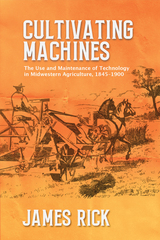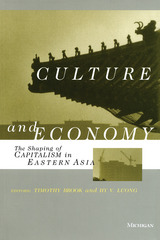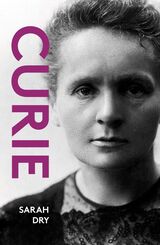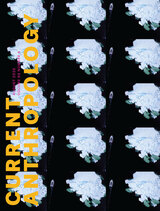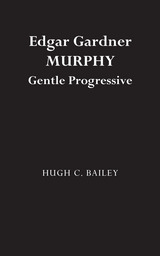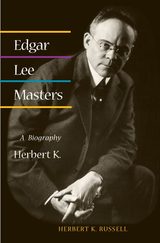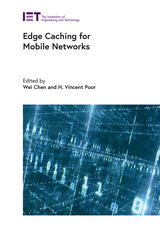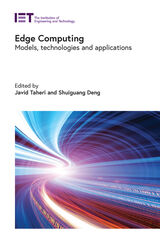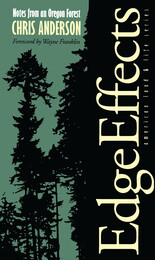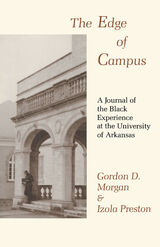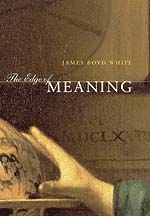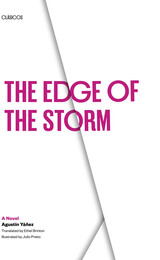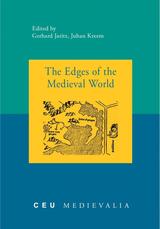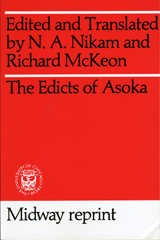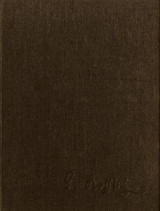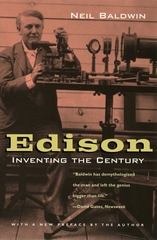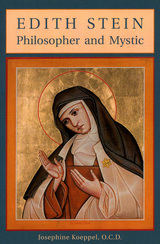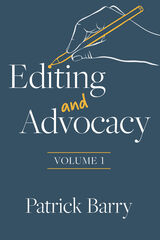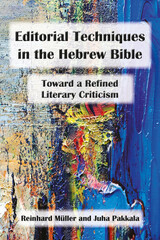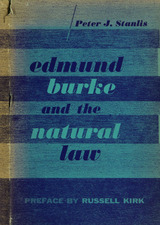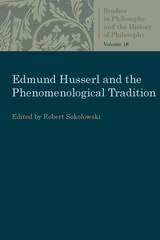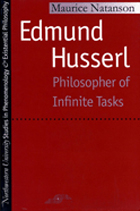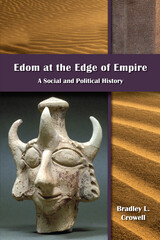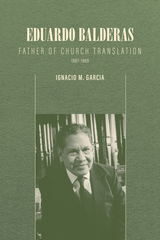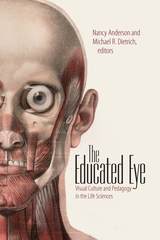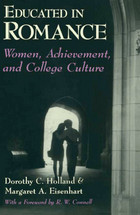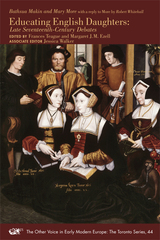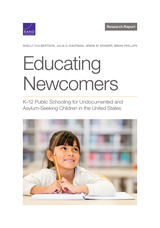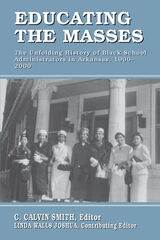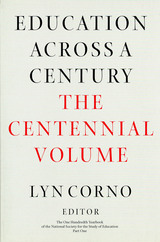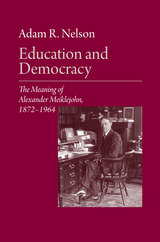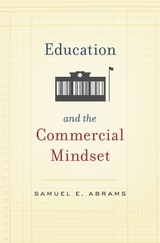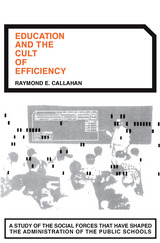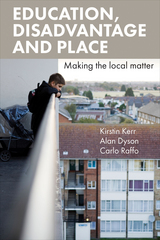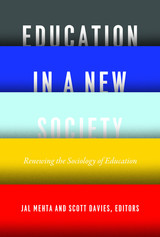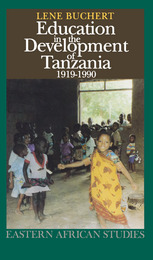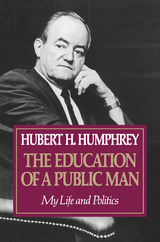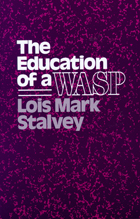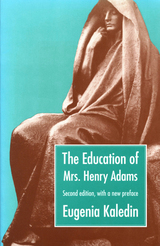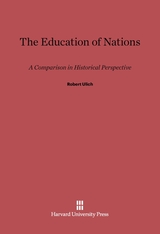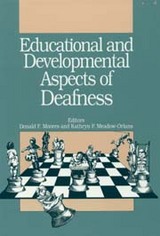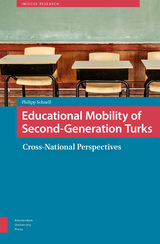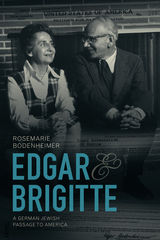 Edgar and Brigitte: A German Jewish Passage to America
Rosemarie Bodenheimer
University of Alabama Press, 2016 Edgar and Brigitte: A German Jewish Passage to America is the fruit of an extraordinary archive of personal journals, letters, speeches, and published writings left by Edgar and Brigitte Bodenheimer, who emigrated from Nazi Germany in 1933 and became American law professors. More German than Jewish, highly educated, and saturated to the core in the German cultural ideal of Bildung, Edgar and Brigitte embody many of the qualities of their generation of German Jews in the late-nineteenth and early-twentieth centuries.
The couple’s encounters with the strange new dynamics of race, religion, and the workplace in their new American home offer a compelling account of the struggles that faced many immigrants with deep German roots. It is also an intimate portrait of a now-vanished German Jewish culture as it played out in the lives of Bodenheimer’s parents and her grandparents from the 1920s to the late 1960s, a story of emigration, assimilation, and the private struggles that accompany those forced shifts in orientation.
The Bodenheimers’ letters and journals offer engaging perspectives into their personal lives that retrospective memories cannot match. Braiding intimate biography together with history and memoir, Edgar and Brigitte will appeal both to historians of the European Jewish diaspora and to readers interested in the struggles and resilience of people whose lives were upended by Hitler.
Edgar Gardner Murphy: Gentle Progressive
Hugh C. Bailey
University of Alabama Press, 2002 “Bailey’s account is sharply focused on Murphy’s public life and thought [and] the result is a well-researched, balanced, straightforward narrative that will serve as the standard authority.” –American Historical Review
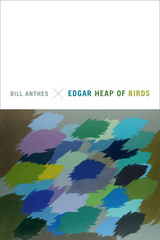 Edgar Heap of Birds
Bill Anthes
Duke University Press, 2015 For over three decades, contemporary Native American artist Hock E Aye Vi Edgar Heap of Birds has pursued a disciplined practice in multiple media, having shown his paintings, drawings, prints, and text-based conceptual art throughout numerous national and international galleries and public spaces. In the first book-length study of this important artist, Bill Anthes analyzes Heap of Birds's art and politics in relation to the international contemporary art scene, Native American history, and settler colonialism. Foregrounding how Heap of Birds roots his practice in Cheyenne spirituality and an indigenous way of seeing and being in the world, Anthes describes how Heap of Birds likens his art to "sharp rocks"—weapons delivering trenchant critiques of the loss of land, life, and autonomy endured by Native Americans. Whether appearing as interventions in public spaces or in a gallery, Heap of Birds's carefully honed artworks pose questions about time, modernity, identity, power, and the meaning and value of contemporary art in a global culture.
Edge Caching for Mobile Networks
Wei Chen
The Institution of Engineering and Technology, 2022 Caching enables the storage of Internet-based content, including web objects, videos and software updates. When web objects are downloaded from the Internet or across wide-area-network (WAN) links, edge caching stores them at the edge of the network. Content can also be proactively cached at the edge based on its predicted popularity. When subsequent requests come for cached material, the content is quickly delivered from edge caching, without the need to download the data again over the WAN. The result is the ability to help save bandwidth, particularly at times of peak network load, increase content delivery, and provide users with a faster and better network experience.
Edge Computing: Models, technologies and applications
Javid Taheri
The Institution of Engineering and Technology, 2020 Cloud computing has evolved as a cost-effective, easy-to-use, elastic and scalable computing paradigm to transform today's business models. 5G, Industrial IoT, Industry 4.0 and China-2050 frameworks and technologies are introducing new challenges that cannot be solved efficiently using current cloud architectures. To handle the collected information from such a vast number of devices and actuators, and address these issues, novel concepts have been proposed to bring cloud-like resources closer to end users at the edge of the network, a technology called edge computing.
Edge Effects: Notes From An Oregon Forest
Chris Anderson
University of Iowa Press, 1993 Buying his dream house several years ago on the forest's edge near Corvallis, Oregon, essayist Chris Anderson hoped to find the joys of rural living. Despite interminable Mr. Blandings experiences, he lived embowered by 12,000 acres of seemingly endless fir trees. But not for long. The McDonald-Dunn Forest was about to become the site of a disturbing research project. Little did Anderson know when he bought his house that, in addition to studying the ecological effects of clear-cutting, the researchers wanted to see how urban fringe dwellers might be affected too. The shock of that harvest compelled the essays in this vibrant, graceful record of the relationship between the forest and Anderson's life on its boundary.
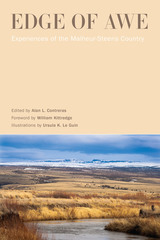 Edge of Awe: Experiences of the Malheur-Steens Country
Alan L. Contreras
Oregon State University Press, 2019 This compelling anthology gathers together personal impressions of the Malheur-Steens country of southeastern Oregon, known for its birding opportunities, its natural beauty and remoteness, and, more recently, for the 2016 armed takeover of the Malheur National Wildlife Refuge. Contributors of poetry and narrative nonfiction include biologists, students, tourists, birders, and local residents, thus reflecting the perspectives of both visitors and residents.
Edge of Awe celebrates the immense variety of human experience in the Malheur-Steens region. This high-desert marsh country has long been a place of human habitation, work, and recreation, but this compendium is weighted toward the writing of visitors over the past one hundred years. It encompasses a wide range of experiences, such as fishing the Blitzen River, attending the Steens Running Camp, leading a mule train on Steens mountain, looking for rare migrant birds, boating on the great marshes, and much more.
Anyone who has visited the awe-inspiring Malheur-Steens country or plans to do so, and anyone with an interest in the region, will find inspiration in this literary companion.
CONTRIBUTORS
Chas Biederman
Charles E. Bendire
Greg Bryant
Sean Burns
Alan L. Contreras
Harry Fuller
Ira N. Gabrielson
Quinton Hallett
Ada Hastings Hedges
David Hedges
Hendrik Herlyn
Meli Hull
William Kittredge
Ursula K. Le Guin
Maitreya
David B. Marshall
John F. Marshall
Tom McAllister
Thomas C. Meinzen
Peter Pearsall
Dallas Lore Sharp
William Stafford
Noah K. Strycker
Peter Walker
Ellen Waterston
C.E.S. Wood
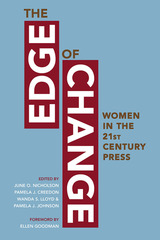 The Edge of Change: Women in the Twenty-First-Century Press
Edited by June O. Nicholson, Pamela J. Creedon, Wanda S. Lloyd, and Pamela J. Jo: Foreword by Ellen Goodman
University of Illinois Press, 2008 Containing nearly three dozen original essays penned by the nation's leading newspaper journalists, editors, and executives, this book advances current discussions regarding women in journalism. Surveying the past quarter century, the book's contributors highlight the unprecedented influence American women have had on the news industry, especially newspapers, and look ahead to the future for women in news. Acclaimed anthropologist and author Helen E. Fisher adds her perspective in examining the role of women across millennia and how the talents of women are changing social and economic life in this global age. Prominent female voices in journalism provide critical perspectives on the challenges women face in today's news organizations, such as connecting with diverse audiences, educating readers about international issues and cultures, maintaining credibility, negotiating media consolidation and corporate pressures, and overcoming the persistent barriers to professional advancement. A powerful and complex assessment of how women are transforming the news industry, The Edge of Change explores how the news industry might implement further reforms aimed at creating a more inclusive journalistic community. Contributors are Catalina Camia, Kathleen Carroll, Pamela J. Creedon, Paula Lynn Ellis, Helen E. Fisher, Dorothy Butler Gilliam, Ellen Goodman, Sharon Grigsby, Carol Guzy, Kirsten Scharnberg Hampton, Cathy Henkel, Pamela J. Johnson, Jane Kirtley, Jan Leach, Caroline Little, Wanda S. Lloyd, Arlene Notoro Morgan, June O. Nicholson, Geneva Overholser, Marty Petty, Deb Price, Donna M. Reed, Sandra Mims Rowe, Peggy Simpson, Margaret Sullivan, Julia Wallace, and Keven Ann Willey.
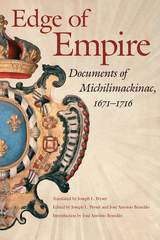 Edge of Empire: Documents of Michilimackinac, 1671-1716
Joseph L. Peyser
Michigan State University Press, 2008 Few places were as important in the seventeenth-century European colonial New World as the pays d’en haut. This term means "upper country" and refers to the western Great Lakes (Huron, Michigan, and Superior) and the areas immediately north, south, and west of them. The region was significant because of its large Native American population, because it had an extensive riverine system needed for beaver populations—essential to the fur trade—and because it held the transportation key to westward expansion.
It was vital to the French, who controlled the region, to be on good terms with its peoples. To maintain good relations through trade and diplomacy with the nations in the pays d’en haut, the French built a number of posts, including one at Michilimackinac and one on the St. Joseph River (near Niles, Michigan). These posts were garrisoned by French troops and run by French commanders who contracted with merchants to manage business matters.
Edge of Empire provides both an overview and an intensely detailed look at Michilimackinac at a very specific period of history. While the introduction offers an overview of the French fur trade, of the place of Michilimackinac in that network, and of what Michilimackinac was like in the years up to 1716, the body of the book is comprised of over sixty French-language documents, now translated into English. Collected from archives in France, Canada, and the United States, the documents identify many of the people involved in the trade and reveal a great deal about the personal and professional relations among people who traded. They also reveal clearly the process by which trade was carried out, including the roles of both Native Americans and women. At the same time, the documents open a window into French colonial society in New France.
 Edge of Empires: Chinese Elites and British Colonials in Hong Kong
John M. Carroll
Harvard University Press, 2005 In an engaging, revisionist study, John M. Carroll argues that in the century after the Opium War, Hong Kong's colonial nature helped create a local Chinese business elite.
By the end of the nineteenth century, the colonial government saw Chinese businessmen as allies in establishing Hong Kong as a commercial center. The idea of a commercially vibrant China united them. Chinese and British leaders cooperated on issues of mutual concern, such as the expansion of capitalism and political and economic directions for an ailing China.
These Chinese also found opportunities in the colonial system to develop business and commerce. In doing so, they used Hong Kong's strategic position to underscore their own identity as a distinctive group unlike their mainland counterparts. Nationalism took on a specifically Hong Kong character. At the same time, by contributing to imperial war funds, organizing ceremonies for visiting British royalty, and attending imperial trade exhibitions, the Chinese helped make Hong Kong an active member of the global British Empire.
In Edge of Empires, Carroll situates Hong Kong squarely within the framework of both Chinese and British colonial history, while exploring larger questions about the meaning and implications of colonialism in modern history.
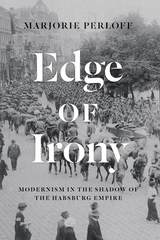 Edge of Irony: Modernism in the Shadow of the Habsburg Empire
Marjorie Perloff
University of Chicago Press, 2016 Among the brilliant writers and thinkers who emerged from the multicultural and multilingual world of the Austro-Hungarian Empire were Joseph Roth, Robert Musil, and Ludwig Wittgenstein. For them, the trauma of World War I included the sudden loss of the geographical entity into which they had been born: in 1918, the empire was dissolved overnight, leaving Austria a small, fragile republic that would last only twenty years before being annexed by Hitler’s Third Reich. In this major reconsideration of European modernism, Marjorie Perloff identifies and explores the aesthetic world that emerged from the rubble of Vienna and other former Habsburg territories—an “Austro-Modernism” that produced a major body of drama, fiction, poetry, and autobiography.
Perloff explores works ranging from Karl Kraus’s drama The Last Days of Mankind and Elias Canetti’s memoir The Tongue Set Free to Ludwig Wittgenstein’s notebooks and Paul Celan’s lyric poetry. Throughout, she shows that Austro-Modernist literature is characterized less by the formal and technical inventions of a modernism familiar to us in the work of Joyce and Pound, Dada and Futurism, than by a radical irony beneath a seemingly conventional surface, an acute sense of exile, and a sensibility more erotic and quixotic than that of its German contemporaries. Skeptical and disillusioned, Austro-Modernism prefers to ask questions rather than formulate answers.
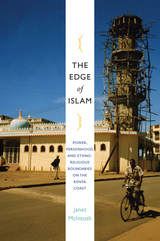 The Edge of Islam: Power, Personhood, and Ethnoreligious Boundaries on the Kenya Coast
Janet McIntosh
Duke University Press, 2009 In this theoretically rich exploration of ethnic and religious tensions, Janet McIntosh demonstrates how the relationship between two ethnic groups in the bustling Kenyan town of Malindi is reflected in and shaped by the different ways the two groups relate to Islam. While Swahili and Giriama peoples are historically interdependent, today Giriama find themselves literally and metaphorically on the margins, peering in at a Swahili life of greater social and economic privilege. Giriama are frustrated to find their ethnic identity disparaged and their versions of Islam sometimes rejected by Swahili. The Edge of Islam explores themes as wide-ranging as spirit possession, divination, healing rituals, madness, symbolic pollution, ideologies of money, linguistic code-switching, and syncretism and its alternatives. McIntosh shows how the differing versions of Islam practiced by Swahili and Giriama, and their differing understandings of personhood, have figured in the growing divisions between the two groups. Her ethnographic analysis helps to explain why Giriama view Islam, a supposedly universal religion, as belonging more deeply to certain ethnic groups than to others; why Giriama use Islam in their rituals despite the fact that so many do not consider the religion their own; and how Giriama appropriations of Islam subtly reinforce a distance between the religion and themselves. The Edge of Islam advances understanding of ethnic essentialism, religious plurality, spirit possession, local conceptions of personhood, and the many meanings of “Islam” across cultures.
The Edge of Meaning
James Boyd White
University of Chicago Press, 2001 Certain questions are basic to the human condition: how we imagine the world, and ourselves and others within it; how we confront the constraints of language and the limits of our own minds; and how we use imagination to give meaning to past experiences and to shape future ones. These are the questions James Boyd White addresses in The Edge of Meaning, exploring each through its application to great works of Western culture—Huckleberry Finn, the Odyssey, and the paintings of Vermeer among them. In doing so, White creates a deeply moving and insightful book and presents an inspiring conception of mind, language, and the essence of living.
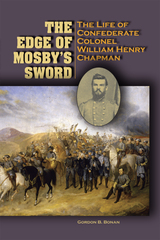 The Edge of Mosby’s Sword: The Life of Confederate Colonel William Henry Chapman
Gordon B. Bonan
Southern Illinois University Press, 2009 The Edge of Mosby’s Sword is the first scholarly volume to delve into the story of one of John Singleton Mosby’s most trusted and respected officers, Colonel William Henry Chapman. Presenting both military and personal perspectives of Chapman’s life, Gordon B. Bonan offers an in-depth understanding of a man transformed by the shattering of his nation. This painstakingly researched account exposes a soldier and patriot whose convictions compelled him to battle fiercely for Southern independence; whose quest for greatness soured when faced with the brutal realities of warfare; and who sought to heal his wounded nation when the guns of war were silenced.
Born into a wealthy slave-owning family, Chapman was a student of the fiery secessionist rhetoric of antebellum Virginia who eagerly sought glory and adventure on the battlefields of the Civil War. Bonan traces Chapman’s evolution from an impassioned student at the University of Virginia to an experienced warrior and leader, providing new insight into the officer’s numerous military accomplishments. Explored here are Chapman’s previously overlooked endeavors as a student warrior, leader of the Dixie Artillery, and as second-in-command to Mosby, including his participation in the capture of Harpers Ferry, the battering of Union forces at Second Manassas, and his ferocious raids during the 1864 Shenandoah Valley campaign. Bonan reveals fresh perspectives on the intrepid maneuvers of Mosby’s Rangers, the hardships of war, and Chapman’s crucial role as the right hand of the “Gray Ghost.” But while Mosby recognized him for his bravery and daring, the fame Chapman sought always eluded him. Instead, with his honors and successes came disillusionment and sorrow, as he watched comrades and civilians alike succumb to the terrible toll of the war. The end of the struggle between North and South saw Chapman accept defeat with dignity, leading the Rangers to their official surrender and parole at Winchester. With the horrors of the war behind him, he quickly moved to embrace the rebuilding of his country, joining the Republican party and beginning a forty-two-year career at the IRS enforcing Federal law throughout the South. In the end, Chapman’s life is a study in contradictions: nationalism and reconciliation; slavery and liberty; vengeance and chivalry.
 The Edge of Surrealism: A Roger Caillois Reader
Roger Caillois, Edited by Claudine Frank
Duke University Press, 2003 The Edge of Surrealism is an essential introduction to the writing of French social theorist Roger Caillois. Caillois was part of the Surrealist avant-garde and in the 1930s founded the College of Sociology with Georges Bataille and Michel Leiris. He spent his life exploring issues raised by this famous group and by Surrealism itself. Though his subjects were diverse, Caillois focused on concerns crucial to modern intellectual life, and his essays offer a unique perspective on many of twentieth-century France’s most significant intellectual movements and figures. Including a masterful introductory essay by Claudine Frank situating his work in the context of his life and intellectual milieu, this anthology is the first comprehensive introduction to Caillois’s work to appear in any language. These thirty-two essays with commentaries strike a balance between Caillois’s political and theoretical writings and between his better known works, such as the popular essays on the praying mantis, myth, and mimicry, and his lesser-known pieces. Presenting several new pieces and drawing on interviews and unpublished correspondence, this book reveals Caillois’s consistent effort to reconcile intellectual rigor and imaginative adventure. Perhaps most importantly, The Edge of Surrealism provides an overdue look at how Caillois’s intellectual project intersected with the work of Georges Bataille and others including Breton, Bachelard, Benjamin, Lacan, and Lévi-Strauss.
 The Edge of the Law: Street Vendors and the Erosion of Citizenship in São Paulo
Jacinto Cuvi
University of Chicago Press, 2025 How street vendors tangle with the law in São Paulo, Brazil.
With a little initiative and very little startup money, an outgoing individual might sell you a number of delights and conveniences familiar to city dwellers—from cold water bottles while you’re sitting in traffic to a popsicle from a cart on a summer afternoon in the park. Such vendors form a significant share of the workforce in São Paulo, Brazil, but their ubiquity belies perpetual struggle. Some have the right to practice their trade; others do not. All of them strive to make it—or stay afloat.
In The Edge of the Law, sociologist Jacinto Cuvi introduces us to the world of street vendors and teases out the relationship between the construction of legality and the experience of citizenship. As São Paulo’s city government undertakes a large-scale plan to cancel street vending licenses and evict street vendors, Cuvi reveals how the rights of informal workers can be revoked or withheld and how the lines can be redrawn between work that is “legal” and work that takes place under constant fear of law enforcement. Alongside the mechanics of disenfranchisement, Cuvi captures the lived experience of criminalization, dissecting the distribution of (shallow) rights among vendors who continually reinvent strategies to eke out a living while dealing with the constraints and pressures of informal citizenship at the edge of the law.
The Edge of the Storm: A Novel
By Agustín Yáñez
University of Texas Press, 1963 This tale of a repressive priest and his small Mexican village during the eighteen months preceding the Revolution of 1910 is a great novel, one that exposes the struggle between human desire and paralyzing fear—fear of humanity, fear of nature, fear of the wrath of God. Agustín Yáñez probes the actions of people caught in life’s currents, enthralling his readers with mounting dramatic tension as he shows that no power can forge saints from the human masses, that any attempt to do so, in fact, often has exactly the opposite result. Yáñez brings to his work a deep understanding of people—his people—and he illuminates a great truth—that no one, anywhere, seems very strange when we understand the environment that has produced him or her.
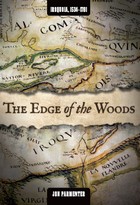 The Edge of the Woods: Iroquoia, 1534-1701
Jon Parmenter
Michigan State University Press, 2010 Drawing on archival and published documents in several languages, archeological data, and Iroquois oral traditions, The Edge of the Woods explores the ways in which spatial mobility represented the geographic expression of Iroquois social, political, and economic priorities. By reconstructing the late precolonial Iroquois settlement landscape and the paths of human mobility that constructed and sustained it, Jon Parmenter challenges the persistent association between Iroquois 'locality' and Iroquois 'culture,' and more fully maps the extended terrain of physical presence and social activity that Iroquois people inhabited. Studying patterns of movement through and between the multiple localities in Iroquois space, the book offers a new understanding of Iroquois peoplehood during this period. According to Parmenter, Iroquois identities adapted, and even strengthened, as the very shape of Iroquois homelands changed dramatically during the seventeenth century.
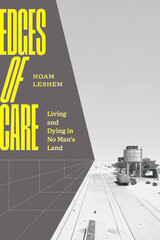 Edges of Care: Living and Dying in No Man’s Land
Noam Leshem
University of Chicago Press, 2025 A firsthand look at the lives of those who reside in no man’s land—the violence they endure and their immense resilience.
“No man’s land” invokes stretches of barren landscape, twisted barbed wire, desolation, and the devastation of war. But this is not always the reality. According to Noam Leshem in Edges of Care, the term also reveals radical abandonment by the state. From the Northern Sahara to the Amazon rainforests, people around the world find themselves in places that have been stripped of sovereign care. Leshem is committed to defining these spaces and providing a more intimate understanding of this urgent political reality.
Based on nearly a decade of research in some of the world’s most challenging conflict zones, Edges of Care offers a profound account of abandoned lives and lands, and how they endure and sometimes thrive once left to fend for themselves. Leshem interrogates no man’s land as a site of radical uncaring: abandoned by a sovereign power in a relinquishment of responsibility for the space or anyone inside it. To understand the ramifications of such uncaring, Leshem takes readers through a diverse series of abandoned places, including areas in Palestine, Syria, Colombia, Sudan, and Cyprus. He shows that no man’s land is not empty of life, but almost always inhabited and, in fact, often generative of new modes of being. Beautifully written and evocative, Edges of Care reveals the unexamined complexities and political dynamics hidden within and around places governed by callous indifference.
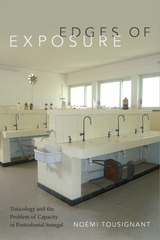 Edges of Exposure: Toxicology and the Problem of Capacity in Postcolonial Senegal
Noémi Tousignant
Duke University Press, 2018 In the industrialized nations of the global North, well-funded agencies like the CDC attend to citizens' health, monitoring and treating for toxic poisons like lead. How do the under-resourced nations of the global South meet such challenges? In Edges of Exposure, Noémi Tousignant traces the work of toxicologists in Senegal as they have sought to warn of and remediate the presence of heavy metals and other poisons in their communities. Situating recent toxic scandals within histories of science and regulation in postcolonial Africa, Tousignant shows how decolonization and structural adjustment have impacted toxicity and toxicology research. Ultimately, as Tousignant reveals, scientists' capacity to conduct research—as determined by material working conditions, levels of public investment, and their creative but not always successful efforts to make visible the harm of toxic poisons—affects their ability to keep equipment, labs, projects, and careers going.
The Edges of the Medieval World
Gerhard Jaritz
Central European University Press, 2009 In the Middles Ages, the edges of one's world could represent different meanings. On the one hand, they might have been situated in far-away regions, mainly in the east and north, that one most often only knew from hearsay and which were inhabited by strange beings: humans with their faces on their chest, without a mouth, or with dog heads. On the other hand, the edges of one's world could just mean the borders of the community where one lived and that one sometimes might not have had the possibility to cross during one's whole life.In this volume specialists from eight European countries offer their ideas about different edges of the medieval world and contribute to a discussion that has been increasing greatly in Medieval Studies in recent times.
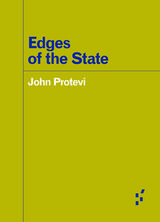 Edges of the State
John Protevi
University of Minnesota Press, 2019 Using philosophical and scientific work to engage the perennial question of human nature
This book takes a look at the formation, and edges, of states: their breakdowns and attempts to repair them, and their encounters with non-state peoples. It draws upon anthropology, political philosophy, neuroscience, evolutionary biology, child developmental psychology, and other fields to look at states as projects of constructing “bodies politic,” where the civic and the somatic intersect. John Protevi asserts that humans are predisposed to “prosociality,” or being emotionally invested in social partners and patterns. With readings from Jean-Jacques Rousseau and James C. Scott; a critique of the assumption of widespread pre-state warfare as a selection pressure for the evolution of human prosociality and altruism; and an examination of the different “economies of violence” of state and non-state societies, Edges of the State sketches a notion of prosocial human nature and its attendant normative maxims.
Forerunners: Ideas First
Short books of thought-in-process scholarship, where intense analysis, questioning, and speculation take the lead
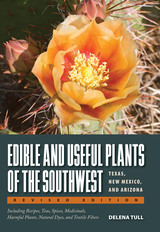 Edible and Useful Plants of the Southwest: Texas, New Mexico, and Arizona
By Delena Tull
University of Texas Press, 2013 All around us there are wild plants useful for food, medicine, and clothing, but most of us don’t know how to identify or use them. Delena Tull amply supplies that knowledge in this book, which she has now expanded to more thoroughly address plants found in New Mexico and Arizona, as well as Texas. Extensively illustrated with black-and-white drawings and color photos, this book includes the following special features: - Recipes for foods made from edible wild plants
- Wild teas and spices
- Wild plant dyes, with instructions for preparing the plants and dying wool, cotton, and other materials
- Instructions for preparing fibers for use in making baskets, textiles, and paper
- Information on wild plants used for making rubber, wax, oil, and soap
- Information on medicinal uses of plants
- Details on hay fever plants and plants that cause rashes
- Instructions for distinguishing edible from poisonous berries
- Detailed information on poisonous plants, including poison ivy, oak, and sumac, as well as herbal treatments for their rashes
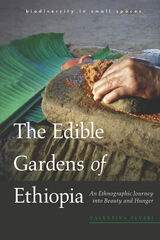 The Edible Gardens of Ethiopia: An Ethnographic Journey into Beauty and Hunger
Valentina Peveri
University of Arizona Press, 2020 What is a beautiful garden to southern Ethiopian farmers? Anchored in the author’s perceptual approach to the people, plants, land, and food, The Edible Gardens of Ethiopia opens a window into the simple beauty and ecological vitality of an ensete garden.
The ensete plant is only one among the many “unloved” crops that are marginalized and pushed close to disappearance by the advance of farming modernization and monocultural thinking. And yet its human companions, caught in a symbiotic and sensuous dialogue with the plant, still relate to each exemplar as having individual appearance, sensibility, charisma, and taste, as an epiphany of beauty and prosperity, and even believe that the plant can feel pain. Here a different story is recounted of these human-plant communities, one of reciprocal love at times practiced in an act of secrecy. The plot unfolds from the subversive and tasteful dimensions of gardening for subsistence and cooking in the garden of ensete through reflections on the cultural and edible dimensions of biodiversity to embrace hunger and beauty as absorbing aesthetic experiences in small-scale agriculture. Through this story, the reader will enter the material and spiritual world of ensete and contemplate it as a modest yet inspiring example of hope in rapidly deteriorating landscapes.
Based on prolonged engagement with this “virtuous” plant of southwestern Ethiopia, this book provides a nuanced reading of the ensete ventricosum (avant-)garden and explores how the life in tiny, diverse, and womanly plots offers alternative visions of nature, food policy, and conservation efforts.
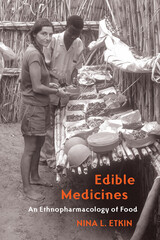 Edible Medicines: An Ethnopharmacology of Food
Nina L. Etkin
University of Arizona Press, 2006 Chile pepper is used today as a flavoring, but Aztecs also applied it for toothache, sore throat, and asthma. The tonic properties of coffee have been recorded in Islamic pharmacopoeia since the eleventh century, and many peoples have used it to protect against Parkinson’s disease. Although much has been documented regarding the nutritional values of foods, until recently little attention has been paid to the pharmacologic potential of diet.
This book investigates the health implications of foods from the cuisines of peoples around the world to describe the place of food in health maintenance. In this wide-ranging book, Nina Etkin reveals the pharmacologic potential of foods in the specific cultural contexts in which they are used. Incorporating co-evolution with a biocultural perspective, she addresses some of the physiological effects of foods across cultures and through history while taking into account both the complex dynamics of food choice and the blurred distinctions between food and medicine. Showing that food choice is more closely linked to health than is commonly thought, she helps us to understand the health implications of people’s food-centered actions in the context of real-life circumstances.
Drawing on an extensive literature that transects food and culture, the history of medicine, ethnopharmacology, food history, nutrition, and human evolution, Edible Medicines demonstrates the intricate relationship between culture and nature. It will appeal to a wide range of scholars and professionals, from anthropologists to nutritionists, as well as general readers seeking a greater understanding of the medicinal aspects of food.
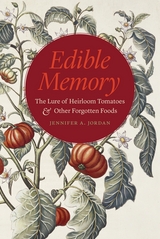 Edible Memory: The Lure of Heirloom Tomatoes and Other Forgotten Foods
Jennifer A. Jordan
University of Chicago Press, 2015 Each week during the growing season, farmers’ markets offer up such delicious treasures as brandywine tomatoes, cosmic purple carrots, pink pearl apples, and chioggia beets—varieties of fruits and vegetables that are prized by home chefs and carefully stewarded by farmers from year to year. These are the heirlooms and the antiques of the food world, endowed with their own rich histories. While cooking techniques and flavor fads have changed from generation to generation, a Ribston Pippin apple today can taste just as flavorful as it did in the eighteenth century. But how does an apple become an antique and a tomato an heirloom? In Edible Memory, Jennifer A. Jordan examines the ways that people around the world have sought to identify and preserve old-fashioned varieties of produce. In doing so, Jordan shows that these fruits and vegetables offer a powerful emotional and physical connection to a shared genetic, cultural, and culinary past.
Jordan begins with the heirloom tomato, inquiring into its botanical origins in South America and its culinary beginnings in Aztec cooking to show how the homely and homegrown tomato has since grown to be an object of wealth and taste, as well as a popular symbol of the farm-to-table and heritage foods movements. She shows how a shift in the 1940s away from open pollination resulted in a narrow range of hybrid tomato crops. But memory and the pursuit of flavor led to intense seed-saving efforts increasing in the 1970s, as local produce and seeds began to be recognized as living windows to the past. In the chapters that follow, Jordan combines lush description and thorough research as she investigates the long history of antique apples; changing tastes in turnips and related foods like kale and parsnips; the movement of vegetables and fruits around the globe in the wake of Columbus; and the poignant, perishable world of stone fruits and tropical fruit, in order to reveal the connections—the edible memories—these heirlooms offer for farmers, gardeners, chefs, diners, and home cooks. This deep culinary connection to the past influences not only the foods we grow and consume, but the ways we shape and imagine our farms, gardens, and local landscapes.
From the farmers’ market to the seed bank to the neighborhood bistro, these foods offer essential keys not only to our past but also to the future of agriculture, the environment, and taste. By cultivating these edible memories, Jordan reveals, we can stay connected to a delicious heritage of historic flavors, and to the pleasures and possibilities for generations of feasts to come.
 Edible Mushrooms
Clyde M. Christensen
University of Minnesota Press, 1981 Edible Mushrooms was first published in 1981. Minnesota Archive Editions uses digital technology to make long-unavailable books once again accessible, and are published unaltered from the original University of Minnesota Press editions. The choicest varieties of mushrooms cannot be cultivated or commercially grown but are available in abundance to those who take the trouble to find them. With this book in hand, anyone can, with confidence, gather and enjoy delicious wild mushrooms without fear of the poisonous varieties. Edible Mushrooms,a new edition of the 1943 classic guide, Common Edible Mushrooms,describes in detail more than 60 of the most abundant and most easily recognized species. Photographs, many in color, show each species in its natural habitat for easy identification. Clyde M. Christensen warns against the poisonous varieties and advises amateur mushroom hunters to become thoroughly familiar with the most common edible mushrooms and to avoid all others. This edition contains new full-color photographs, and new material on how mushrooms grow and how to identify and collect them. Christensen has updated the classification to bring scientific names into agreement with internationally approved nomenclature but retains the older technical names in parentheses for easy comparison with other guides. An enlarged section of recipes provides good ideas for making the most of a mushroom harvest.
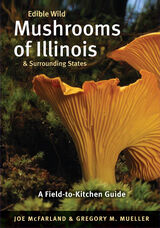 Edible Wild Mushrooms of Illinois and Surrounding States: A Field-to-Kitchen Guide
Joe McFarland and Gregory M. Mueller
University of Illinois Press, 2008 Lavishly illustrated with nearly three hundred gorgeous full-color photos, this engaging guidebook carefully describes forty different edible species of wild mushrooms found around Illinois and surrounding states, including Iowa, Wisconsin, Missouri, Indiana, and Kentucky. With conversational and witty prose, the book provides extensive detail on each edible species, including photographs of potential look-alikes to help you safely identify and avoid poisonous species. Mushroom lovers from Chicago to Cairo will find their favorite local varieties, including morels, chanterelles, boletes, puffballs, and many others. Veteran mushroom hunters Joe McFarland and Gregory M. Mueller also impart their wisdom about the best times and places to find these hidden gems. Edible Wild Mushrooms of Illinois and Surrounding States also offers practical advice on preparing, storing, drying, and cooking with wild mushrooms, presenting more than two dozen tantalizing mushroom recipes from some of the best restaurants and chefs in Illinois, including one of Food & Wine magazine's top 10 new chefs of 2007. Recipes include classics like Beer Battered Morels, Parasol Mushroom Frittatas, and even the highly improbable (yet delectable) Morel Tiramisu for dessert. As the first new book about Illinois mushrooms in more than eighty years, this is the guide that mushroom hunters and cooks have been craving. Visit the book's companion website at www.illinoismushrooms.com.
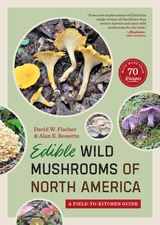 Edible Wild Mushrooms of North America: A Field-to-kitchen Guide
By David W. Fischer and Alan E. Bessette
University of Texas Press, 1992 Unusual shapes and colors make many mushrooms alluring to the eye, while the exotic flavors and textures of edible mushrooms are a gourmet delicacy for the palate. Yet many people never venture beyond the supermarket offerings, fearing that all other mushrooms are poisonous. With amateur mushroom hunters especially in mind, David Fischer and Alan Bessette have prepared Edible Wild Mushrooms of North America. This field guide presents more than 100 species of the most delicious mushrooms, along with detailed information on how to find, gather, store, and prepare them for the table. More than 70 savory recipes, ranging from soups and salads to casseroles, canapes, quiches, and even a dessert, are included. Throughout, the authors constantly emphasize the need for correct identification of species for safe eating. Each species is described in detailed, nontechnical language, accompanied by a list of key identifying characteristics that reliably rule out all but the target species. Superb color photographs also aid in identification. Poisonous "lookalikes" are described and illustrated, and the authors also assess the risks of allergic or idiosyncratic reactions to edible species and the possibilities of chemical or bacterial contamination.
Edicts of Asoka
Edited by N. A. Nikam and Richard McKeon
University of Chicago Press, 1978 "A literary translation which is also easy and pleasing to read."—Ludwik Sternbach, Journal of the American Oriental Society
Edison: Inventing the Century
Neil Baldwin
University of Chicago Press, 2001 The genius of America's most prolific inventor, Thomas Edison, is widely acknowledged, and Edison himself has become an almost mythic figure. But how much do we really know about the man who considered deriving rubber from a goldenrod plant as opposed to the genius who gave us electric light? Neil Baldwin gives us a complex portrait of the inventor himself—both myth and man—and a multifaceted account of the intellectual climate of the country he worked in and irrevocably changed.
Edison's Electric Light
Friedel, Robert
Rutgers University Press, 1986 So encrusted with folklore has Edison's invention of the electric light become that we may be hard-pressed to recognize its significance. This account, unlike others, focuses on the invention rather than the inventor to remind us how extraordinary an achievement it was. Friedel and his colleagues draw chiefly on notes, calculations, and sketches from Edison's laboratory notebooks as well as other contemporary records to re-create the process of invention. Eminently readable and meticulously researched, this illustrated volume is a scholarly work of high order. It belongs in every research collection and in most general collections as well.
 Edited Clean Version: Technology and the Culture of Control
Raiford Guins
University of Minnesota Press, 2009 Where is censorship in the age of digital technology? Not long ago it would have been an absurd idea to purchase a television, CD or MP3 or DVD player, computer software, or game console with the intention of limiting its capabilities. However, as Raiford Guins demonstrates in Edited Clean Version, today’s media technology is marketed and sold for what it does not contain and what it will not deliver. TVs equipped with V-chips, Internet filters, editing DVD players, clean-version CDs and MP3s, and game consoles with parental control features can block out, monitor, disable, and filter information. As Guins argues in this provocative book, consumers now find themselves in new relationships with their everyday media in which they inscribe their viewing, listening, and playing experiences with self-prescribed and technologically enabled values and morals. Censorial practices are not so much enacted on media by regulatory bodies today as they are in our media technology.According to Guins, these new “control technologies” are designed to embody an ethos of neoliberal governance—through the very media that have been previously presumed to warrant management, legislation, and policing. Repositioned within a discourse of empowerment, security, and choice, the action of regulation, he reveals, has been relocated into the hands of users.
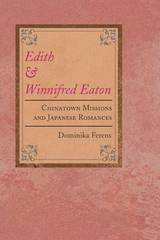 Edith and Winnifred Eaton: Chinatown Missions and Japanese Romances
Dominika Ferens
University of Illinois Press, 2002 Daughters of a British father and a Chinese mother, Edith and Winnifred Eaton pursued wildly different paths. While Edith wrote stories of downtrodden Chinese immigrants under the pen name Sui Sin Far, Winnifred presented herself as Japanese American and published Japanese romance novels in English under the name Onoto Watanna. In this invigorating reappraisal of the vision and accomplishments of the Eaton sisters, Dominika Ferens departs boldly from the dichotomy that has informed most commentary on them: Edith's "authentic" representations of Chinese North Americans versus Winnifred's "phony" portrayals of Japanese characters and settings.
Arguing that Edith as much as Winnifred constructed her persona along with her pen name, Ferens considers the fiction of both Eaton sisters as ethnography. Edith and Winnifred Eaton suggests that both authors wrote through the filter of contemporary ethnographic discourse on the Far East and also wrote for readers hungry for "authentic" insight into the morals, manners, and mentality of an exotic other.
Ferens traces two distinct discursive traditions–-missionary and travel writing–-that shaped the meanings of "China" and "Japan" in the nineteenth century. She shows how these traditions intersected with the unconventional literary careers of the Eaton sisters, informing the sober, moralistic tone of Edith's stories as well as Winnifred's exotic narrative style, plots, settings, and characterizations.
Bringing to the Eatons' writings a contemporary understanding of the racial and textual politics of ethnographic writing, this important account shows how these two very different writers claimed ethnographic authority, how they used that authority to explore ideas of difference, race, class and gender, and how their depictions of nonwhites worked to disrupt the process of whites' self-definition.
Edith Stein: Philosopher and Mystic
Josephine Koeppel O.C.D.
University of Scranton Press, 2007 The twentieth anniversary of the beatification of Edith Stein (1891–1942), the accomplished Jewish philosopher who made a spiritual journey from atheism to agnosticism before eventually converting to Catholicism, will be celebrated in 2007. In Edith Stein: Philosopher and Mystic, Josephine Koeppel chronicles the life of this influential saint from her secular youth and entrance into a German monastery to her tragic death at Auschwitz. This accessible work will reward readers of all faiths interested in the life of a remarkable woman who changed the modern conception of sainthood.
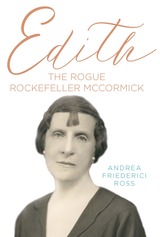 Edith: The Rogue Rockefeller McCormick
Andrea Friederici Ross
Southern Illinois University Press, 2021 WINNER, 2021 Chicago Writers Association Book of the Year in Traditional Nonfiction!
Chicago’s quirky patron saint This thrilling story of a daughter of America’s foremost industrialist, John D. Rockefeller, is complete with sex, money, mental illness, and opera divas—and a woman who strove for the independence to make her own choices. Rejecting the limited gender role carved out for her by her father and society, Edith Rockefeller McCormick forged her own path, despite pushback from her family and ultimate financial ruin. Young Edith and her siblings had access to the best educators in the world, but the girls were not taught how to handle the family money; that responsibility was reserved for their younger brother. A parsimonious upbringing did little to prepare Edith for life after marriage to Harold McCormick, son of the Reaper King Cyrus McCormick. The rich young couple spent lavishly. They purchased treasures like the jewels of Catherine the Great, entertained in grand style in a Chicago mansion, and contributed to the city’s cultural uplift, founding the Chicago Grand Opera. They supported free health care for the poor, founding and supporting the John R. McCormick Memorial Institute for Infectious Diseases. Later, Edith donated land for what would become Brookfield Zoo. Though she lived a seemingly enviable life, Edith’s disposition was ill-suited for the mores of the time. Societal and personal issues—not least of which were the deaths of two of her five children—caused Edith to experience phobias and panic attacks. Dissatisfied with rest cures, she ignored her father’s expectations, moved her family to Zurich, and embarked on a journey of education and self-examination. Edith pursued analysis with then-unknown Carl Jung. Her generosity of spirit led Edith to become Jung’s leading patron. She also supported up-and-coming musicians, artists, and writers, including James Joyce as he wrote Ulysses. While Edith became a Jungian analyst, her husband, Harold, pursued an affair with an opera star. After returning to Chicago and divorcing Harold, Edith continued to deplete her fortune. She hoped to create something of lasting value, such as a utopian community and affordable homes for the middle class. Edith’s goals caused further difficulties in her relationship with her father and are why he and her brother cut her off from the family funds even after the 1929 stock market crash ruined her. Edith’s death from breast cancer three years later was mourned by thousands of Chicagoans. Respectful and truthful, Andrea Friederici Ross presents the full arc of this amazing woman’s life and expertly helps readers understand Edith’s generosity, intelligence, and fierce determination to change the world
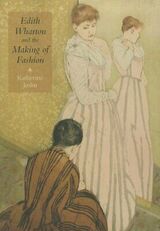 Edith Wharton and the Making of Fashion
Katherine Joslin
University of New Hampshire Press, 2011 Edith Wharton and the Making of Fashion places the iconic New York figure and her writing in the context of fashion history and shows how dress lies at the very center of her thinking about art and culture. The study traces American patronage of the Paris couture houses from Worth and Doucet through Poiret and Chanel and places Wharton's characters in these establishments and garments to offer fresh readings of her well-known novels. Less known are Wharton's knowledge of and involvement in the craft of garment making in her tales of seamstresses, milliners, and textile workers, as well as in her creation of workshops in Paris during the First World War to employ Belgian and French seamstresses and promote the value of handmade garments in a world given to machine-driven uniformity of design and labor. Pointing the way toward further research and inquiry, Katherine Joslin has produced a truly interdisciplinary work that combines the best of literary criticism with an infectious love and appreciation of material culture.
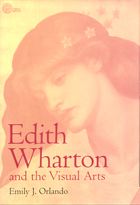 Edith Wharton and the Visual Arts
Emily J. Orlando
University of Alabama Press, 2008 An insightful look at representations of women’s bodies and female authority. This work explores Edith Wharton's career-long concern with a 19th-century visual culture that limited female artistic agency and expression. Wharton repeatedly invoked the visual arts--especially painting—as a medium for revealing the ways that women's bodies have been represented (as passive, sexualized, infantalized, sickly, dead). Well-versed in the Italian masters, Wharton made special use of the art of the Pre-Raphaelite Brotherhood, particularly its penchant for producing not portraits of individual women but instead icons onto whose bodies male desire is superimposed. Emily Orlando contends that while Wharton's early work presents women enshrined by men through art, the middle and later fiction shifts the seat of power to women. From Lily Bart in The House of Mirth to Undine Spragg in The Custom of the Country and Ellen Olenska in The Age of Innocence, women evolve from victims to vital agents, securing for themselves a more empowering and satisfying relationship to art and to their own identities. Orlando also studies the lesser-known short stories and novels, revealing Wharton’s re-workings of texts by Browning, Poe, Balzac, George Eliot, Sir Joshua Reynolds, and, most significantly, Dante Gabriel Rossetti. Edith Wharton and the Visual Arts is the first extended study to examine the presence in Wharton's fiction of the Pre-Raphaelite poetry and painting of Rossetti and his muses, notably Elizabeth Siddall and Jane Morris. Wharton emerges as one of American literature's most gifted inter-textual realists, providing a vivid lens through which to view issues of power, resistance, and social change as they surface in American literature and culture.
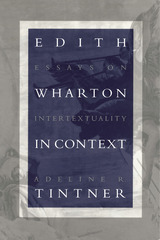 Edith Wharton in Context: Essays on Intertextuality
Adeline R. Tintner
University of Alabama Press, 1999 Tintner provides a detailed analysis of the complex interplay between Wharton and James—how they influenced each other and how some of their writings operate as homages or personal jokes. So deeply was James in Wharton’s confidence, Tintner argues, that he provided her with source models for a number of her characters. In addition, Wharton found in his fiction structures for her own, especially for The Age of Innocence.
Tintner also brings her considerable knowledge of art history to bear in her study of art allusions in Wharton’s work. Wharton’s response both to the Italian painters active before Raphael and to the English Pre-Raphaelites of a generation before her own is analyzed here in three essays. These pieces demonstrate Wharton’s sensibility to changes in art tastes and collecting, the inheritance of Rossetti’s revolutionary paintings in the unfinished novel, The Buccaneers, and the importance of home in The Glimpses of the Moon, as demonstrated by Wharton’s use of Tiepolo’s fresco in the church of Scalzi.
Tintner concludes by considering Wharton’s literary legacy and who Wharton has figured in the imaginations of recent writers, including Richard Howard, Louis Auchincloss, and Cathleen Schine. Tintner finds some part of Wharton’s personality or work evoked in a number of contemporary works and argues that this presence signals the beginning of an increasing influence.
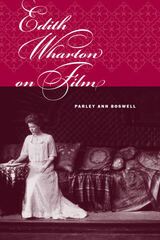 Edith Wharton on Film
Parley Ann Boswell
Southern Illinois University Press, 2007 Edith Wharton (1862–1937), who lived nearly half of her life during the cinema age when she published many of her well-known works, acknowledged that she disliked the movies, characterizing them as an enemy of the imagination. Yet her fiction often referenced film and popular Hollywood culture, and she even sold the rights to several of her novels to Hollywood studios. Edith Wharton on Film explores these seeming contradictions and examines the relationships among Wharton’s writings, the popular culture in which she published them, and the subsequent film adaptations of her work (three from the 1930s and four from the 1990s). Author Parley Ann Boswell examines the texts in which Wharton referenced film and Hollywood culture and evaluates the extant films adapted from Wharton’s fiction. The volume introduces Wharton’s use of cinema culture in her fiction through the 1917 novella Summer, written during the nation’s first wave of feminism, in which the heroine Charity Royall is moviegoer and new American woman, consumer and consumable. Boswell considers the source of this conformity and entrapment, especially for women. She discloses how Wharton struggled to write popular stories and then how she revealed her antipathy toward popular movie culture in two late novels. Boswell describes Wharton’s financial dependence on the American movie industry, which fueled her antagonism toward Hollywood culture, her well-documented disdain for popular culture, and her struggles to publish in women’s magazines. This first full-length study that examines the film adaptations of Wharton’s fiction covers seven films adapted from Wharton’s works between 1930 and 2000 and the fifty-year gap in Wharton film adaptations. The study also analyzes Sophy Viner in The Reef as pre-Hollywood ingénue, characters in Twilight Sleep and The Children and the real Hollywood figures who might have inspired them, and The Sheik and racial stereotypes. Boswell traces the complicated relationship of fiction and narrative film, the adaptations and cinematic metaphors of Wharton’s work in the 1990s, and Wharton’s persona as an outsider. Wharton’s fiction on film corresponds in striking ways to American noir cinema, says Boswell, because contemporary filmmakers recognize and celebrate the subversive qualities of Wharton’s work. Edith Wharton on Film, which includes eleven illustrations, enhances Wharton’s stature as a major American author and provides persuasive evidence that her fiction should be read as American noir literature.
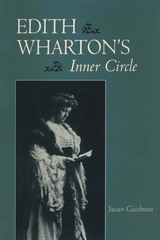 Edith Wharton's Inner Circle
By Susan Goodman
University of Texas Press, 1994 When Edith Wharton became friends with Henry James, she joined a group of men who became her "inner circle." This group included both well-known figures, such as James, Percy Lubbock, and Bernard Berenson, and several now forgotten, including John Hugh Smith, Walter Berry, Gaillard Lapsley, Robert Norton, and Howard Sturgis.
Drawing on unpublished archival material by and about members of the circle, Susan Goodman here presents an intimate view of this American expatriate community, as well as the larger transatlantic culture it mirrored. She explores how the group, which began forming around 1904 and lasted until Wharton's death in 1937, defined itself against the society its founders had left in the United States, while simultaneously criticizing and accommodating the one it found in Europe. Tracing Wharton's individual relationships with these men and their relationships with one another, she examines literary kinships and movements in the biographical and feminist context of gender, exile, and aesthetics. She also relates the group to other literary circles, such as the Bloomsbury group and Gertrude Stein's salon.
Editing and Advocacy
Patrick Barry
Michigan Publishing, 2022 Good editors don’t just see the sentence that was written. They see the sentence that might have been written. They know how to spot words that shouldn’t be included and summon up ones that haven’t yet appeared. Their value comes not just from preventing mistakes but from discovering new ways to improve a piece of writing’s style, structure, and overall impact.
This book— which is based on a popular course taught at the University of Chicago Law School, the University of Michigan Law School, and the UCLA School of Law— is designed to help you become one of those editors. You’ll learn how to edit with empathy. You’ll learn how to edit with statistics. You’ll learn, in short, a wide range of compositional skills you can use to elevate your advocacy and better champion the causes you care about the most.
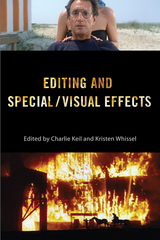 Editing and Special/Visual Effects
Keil, Charlie
Rutgers University Press, 2016 Most moviegoers think of editing and special effects as distinct components of the filmmaking process. We might even conceive of them as polar opposites, since effective film editing is often subtle and almost invisible, whereas special effects frequently call attention to themselves. Yet, film editors and visual effects artists have worked hand-in-hand from the dawn of cinema to the present day. Editing and Special/Visual Effects brings together a diverse range of film scholars who trace how the arts of editing and effects have evolved in tandem. Collectively, the contributors demonstrate how these two crafts have been integral to cinematic history, starting with the “trick films” of the early silent era, which astounded audiences by splicing in or editing out key frames, all the way up to cutting-edge effects technologies and concealed edits used to create the illusions. Throughout, readers learn about a variety of filmmaking techniques, from classic Hollywood’s rear projection and matte shots to the fast cuts and wall-to-wall CGI of the contemporary blockbuster. In addition to providing a rich historical overview, Editing and Special/Visual Effects supplies multiple perspectives on these twinned crafts, introducing readers to the analog and digital tools used in each craft, showing the impact of changes in the film industry, and giving the reader a new appreciation for the processes of artistic collaboration they involve.
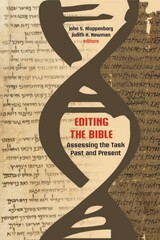 Editing the Bible: Assessing the Task Past and Present
John S. Kloppenborg
SBL Press, 2012 The Bible is likely the most-edited book in history, yet the task of editing the Hebrew, Aramaic, and Greek texts of the Bible is fraught with difficulties. The dearth of Hebrew manuscripts of the Jewish Scriptures and the substantial differences among those witnesses creates difficulties in determining which text ought to be printed as the text of the Jewish Scriptures. For the New Testament, it is not the dearth of manuscripts but the overwhelming number of manuscripts—almost six thousand Greek manuscripts and many more in other languages—that presents challenges for sorting and analyzing such a large, multivariant data set. This volume, representing experts in the editing of the Hebrew Bible and the New Testament, discusses both current achievements and future challenges in creating modern editions of the biblical texts in their original languages. The contributors are Kristin De Troyer, Michael W. Holmes, John S. Kloppenborg, Sarianna Metso, Judith H. Newman, Holger Strutwolf, Eibert Tigchelaar, David Trobisch, Eugene Ulrich, John Van Seters, Klaus Wachtel, and Ryan Wettlaufer.
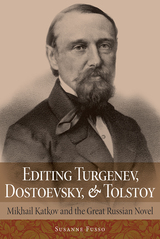 Editing Turgenev, Dostoevsky, and Tolstoy: Mikhail Katkov and the Great Russian Novel
Susanne Fusso
Northern Illinois University Press, 2017 Fathers and Sons by Turgenev. Anna Karenina by Tolstoy. Crime and Punishment by Dostoevsky. These are a few of the great works of Russian prose that first appeared in the Russian Herald, a journal founded and edited by Mikhail Katkov. Yet because of his conservative politics and intrusive editing practices, Katkov has been either ignored or demonized by scholars in both Russia and the West. In Putin’s Russia, he is now being hailed as the “savior of the fatherland” due to his aggressive Russian nationalism. In Editing Turgenev, Dostoevsky, and Tolstoy, Susanne Fusso examines Katkov’s literary career without vilification or canonization, focusing on the ways in which his nationalism fueled his drive to create a canon of Russian literature and support its recognition around the world.
In each chapter, Fusso considers Katkov’s relationship with a major Russian literary figure. In addition to Turgenev, Dostoevsky, and Tolstoy, she explores Katkov’s interactions with Vissarion Belinsky, Evgeniia Tur, and the legacy of Aleksandr Pushkin. As a writer of articles and editorials, Katkov presented a clear program for Russian literature: to affirm the political and historical importance of the Russian nationality as expressed through its language. As a powerful and entrepreneurial publisher, he also sought, encouraged, and paid for the writing of the works that were to embody that program, the works we now recognize as among the greatest achievements of Russian literature. This groundbreaking study will fascinate scholars, students, and general readers interested in Russian literature and literary history.
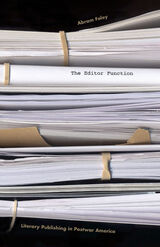 The Editor Function: Literary Publishing in Postwar America
Abram Foley
University of Minnesota Press, 2021 Offering the everyday tasks of literary editors as inspired sources of postwar literary history
Michel Foucault famously theorized “the author function” in his 1969 essay “What Is an Author?” proposing that the existence of the author limits textual meaning. Abram Foley shows a similar critique at work in the labor of several postwar editors who sought to question and undo the corporate “editorial/industrial complex.” Marking an end to the powerful trope of the editor as gatekeeper, The Editor Function demonstrates how practices of editing and publishing constitute their own kinds of thought, calling on us to rethink what we read and how. The Editor Function follows avant-garde American literary editors and the publishing practices they developed to compete against the postwar corporate consolidation of the publishing industry. Foley studies editing and publishing through archival readings and small press and literary journal publishing lists as unique sites for literary inquiry. Pairing histories and analyses of well- and lesser-known figures and publishing formations, from Cid Corman’s Origin and Nathaniel Mackey’s Hambone to Dalkey Archive Press and Semiotext(e), Foley offers the first in-depth engagement with major publishing initiatives in the postwar United States. The Editor Function proposes that from the seemingly mundane tasks of these editors—routine editorial correspondence, line editing, list formation—emerge visions of new, better worlds and new textual and conceptual spaces for collective action.
Editorial Techniques in the Hebrew Bible: Toward a Refined Literary Criticism
Reinhard Müller
SBL Press, 2022 Editorial Techniques in the Hebrew Bible: Toward a Refined Literary Criticism presents and applies a model for understanding and reconstructing the diachronic development of the Hebrew Bible through historical criticism (or the historical-critical method). Reinhard Müller and Juha Pakkala refine the methodologies of literary and redaction criticism through a systematic investigation of the evidence of additions, omissions, replacements, and transpositions that are documented by divergent ancient textual traditions. At stake is not only historical criticism but also the Hebrew Bible as a historical source, for historical criticism has been and continues to be the only method to unwind those scribal changes that left no traces in textual variants.
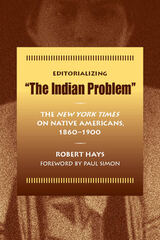 Editorializing "The Indian Problem": The New York Times on Native Americans, 1860-1900
Robert Hays. Foreword by: Paul Simon
Southern Illinois University Press, 2007 Drawing on four decades of New York Times editorials, Robert Hays demonstrates the magnitude of the conflict between Native American and white European cultures as settlers and adventurers spread rapidly across the continent in the post–Civil War period.
From 1860 through 1900, the Times published nearly a thousand editorials on what was commonly called “the Indian problem.” Selecting some of the best of these editorials, Hays gives readers what current accounts cannot: contemporary writers’ perspectives on the public images of Native Americans and their place in a nation bent on expansion. Some editorials express the unbridled bitterness and raw ambition of a nation immersed in an agenda of conquest, while others resonate with the struggle to find a common ground. Still others evince an attitude of respect, which set the tone for reconciling national ambition with natural rights.
American history demonstrates time and again the price of Manifest Destiny. Many of the issues confronting nineteenth-century Native Americans remain alive today: unemployment, infant mortality, suicide, crime, alcoholism, and poverty. In presenting the authentic and urgent voices of a national newspaper’s daily record, Hays illuminates the roots of our current challenges.
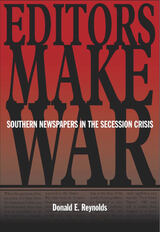 Editors Make War
Donald E. Reynolds
Southern Illinois University Press, 2006 In early 1860 most Southern newspapers promoted Unionist sentiments for peace, but by 1861 they advocated secession and disunion, often calling for bloodshed. Using the editorials published in 196 newspapers during that pivotal year before the outbreak of the Civil War, Donald E. Reynolds shows the evolution of the editors’ viewpoints and explains how editors helped influence the traditionally conservative and nationalistic South to revolt and secede.
Editors Make War is the first complete study of how Southern newspapers influenced the secession crisis in 1860, effectively outlining how editors played on their readers’ racial fears and distrust of the North. Showing how newspaper coverage can affect its readers, this classic study illuminates such events as the nominating conventions, fires in Texas that were blamed on slaves and abolitionists, state elections in the North, Lincoln’s presidential victory, failed attempts at compromise, the secession of the lower Southern states, the attack at Fort Sumter, and the Federal call for troops in April 1861.
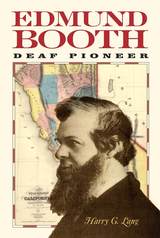 Edmund Booth: Deaf Pioneer
Harry G. Lang
Gallaudet University Press, 2004 Edmund Booth was born in 1810 and died in 1905, and during the 94 years of his life, he epitomized virtually everything that characterized an American legend of that century. In his prime, Booth stood 6 feet, 3 inches tall, weighed in at 210 pounds, and wore a long, full beard. He taught school in Hartford, CT, then followed his wife-to-be Mary Ann Walworth west to Anamosa, Iowa, where in 1840, he built the area’s first frame house. He pulled up stakes nine years later to travel the Overland Trail on his way to join the California Gold Rush. After he returned to Iowa in 1854, he became the editor of the Anamosa Eureka, the local newspaper. Edmund Booth fit perfectly the mold of the ingenious pioneer of 19th-century America, except for one unusual difference — he was deaf.
Edmund Booth: Deaf Pioneer follows the amazing career of this American original and his equally amazing wife in fascinating detail. Author Harry G. Lang vividly portrays Booth and his wife by drawing from a remarkable array of original material. A prolific writer, Booth corresponded with his fiancé from the American School for the Deaf in Hartford, and he kept a journal during his days on the California trail, parts of which have been reproduced here. He also wrote an autobiographical essay when he was 75, and his many newspaper articles through the years bore first-hand witness to the history of his times, from the Civil War to the advent of the 20th century.
Edmund Booth depicts a larger-than-life man in larger-than-life times, but perhaps its greatest contribution derives from its narrative about pioneer days as seen through Deaf eyes. Booth became a respected senior statesman of the American Deaf community, and blended with his stories of the era’s events are anecdotes and issues vital to Deaf people and their families. His story proves again that extraordinary people vary in many ways, but they often possess a common motive in acting to enhance their own communities.
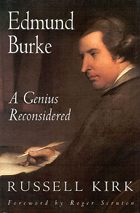 Edmund Burke: A Genius Reconsidered
Russell Kirk
Intercollegiate Studies Institute, 1997
In this, the liveliest and most accessible one-volume life of Edmund Burke, Russell Kirk ingeniously combines into a living whole the private and the public Burke. He gives us a fresh assessment of the great statesman, who enjoys even greater influence today than in his own time. Russell Kirk was a leading figure in the post-World War II revival of American interest in Edmund Burke. Today, no one who takes seriously the problems of society dares remain indifferent to "the first conservative of our time of troubles." In Russell Kirk’s words: "Burke’s ideas interest anyone nowadays, including men bitterly dissenting from his conclusions. If conservatives would know what they defend, Burke is their touchstone; and if radicals wish to test the temper of their opposition, they should turn to Burke." Kirk lucidly unfolds Burke’s philosophy, showing how it revealed itself in concrete historical situations during the eighteenth century and how Burke, through his philosophy, "speaks to our age."
This volume makes vivid the four great struggles in the life of Burke: his efforts to reconcile England with the American colonies; his involvements in cutting down the domestic power of George III; his prosecution of Warren Hastings, the Governor General of India; and his resistance to Jacobinism, the French Revolution’s "armed doctrine." In each of these great phases of his public life, Burke fought with passionate eloquence and relentless logic for justice and for the proper balance of order and freedom. With sure instinct born of his sympathy and understanding, Kirk gives us the incisive quotation, the illuminating highlight, the moving, all-too-human elements that bring Burke and his age to vivid life. Thanks to Russell Kirk’s skillful evocations, Edmund Burke in these pages becomes our contemporary. "Because corruption and fanaticism assail our era as sorely as they did Burke’s time, the resonance of Burke’s voice still is heard amidst the howl of our winds of abstract doctrine."
 Edmund Burke: A Philosophical Enquiry into the Origin of our Ideas of the Sublime and Beautiful
Edmund Burke
University of Notre Dame Press, 1968 In his Enquiry —which has been described as "certainly one of the most important aesthetic documents that eighteenth-century England produced"—the young Edmund Burke provided a systematic analysis of the 'sublime' and the 'beautiful,' together with a distinctive terminology which served to express certain facets of the changing sensibility of his time.
The introduction traces the main sources of Burke’s ideas and establishes the nature of his originality. The largest section of James T. Boulton’s introduction, however, examines the influence of the Enquiry. Major writers like Johnson, Wordsworth and Thomas Hardy, painters such as Fuseli and Mortimer, and critics such as Diderot, Lessing and Kant, as well as many other minor figures, recognized Burke’s new insights, and in varying degrees assimilated them. The second edition, revised by Burke himself, provides the copy-text, including changes between the first and second editions.
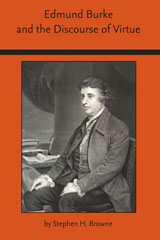 Edmund Burke and the Discourse of Virtue
Stephen Howard Browne
University of Alabama Press, 2007 "A major accomplishment in the study of Burke." —Choice
More than 200 years after his death, Edmund Burke remains among the most influential conservative writers in the Anglophone world. Burke’s relevance has only grown as the nature of what it means to be a conservative has become hotly contested.
And yet Burke is often discussed more than he is read. Worse, his rhetoric is often pressed into the service of other ideologies. In Edmund Burke and the Discourse of Virtue, Stephen Browne of Pennsylvania State University subjects Burke’s work to the close textual analysis it has never received.
The result of Browne's study is to present Burke and his work in a light that was clearly essential to Burke himself, one that illuminates the link between rhetoric and action that is key to understanding Burke, his career, his work, and his influence on contemporary conservatism.
Readers interested in the development of conversative philosophy, politics, and writing from its earliest roots will value this rare and illuminating work.
Edmund Burke and the Natural Law
Peter J. Stanlis
University of Michigan Press, 1958 Edmund Burke—brilliant prophet, party leader, and rhetorician—in his defense of the American Colonies as in his opposition to the French Revolution spoke directly to the modern age. Yet he has been, when not neglected, persistently misunderstood: his principles of prudence garbled, his distrust of abstract law misinterpreted, his appeals to nature misrepresented, his concept of the law of nations ignore. This study of his ideas presents at last his true position as a philosopher, relating his convictions to the great tradition of Christian and classical civilization and showing their relevance for today.
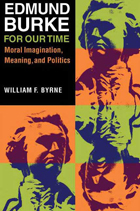 Edmund Burke for Our Time: Moral Imagination, Meaning, and Politics
William F. Byrne
Northern Illinois University Press, 2011
This highly readable book offers a contemporary interpretation of the political thought of Edmund Burke, drawing on his experiences to illuminate and address fundamental questions of politics and society that are of particular interest today. For Burke, one’s imaginative context provides meaning and is central to judgment and behavior. Many of Burke’s ideas can be brought together around his concept of the “moral imagination,” which has received little systematic treatment in the context of Burke’s own experience.
In Edmund Burke for Our Time, Byrne asserts that Burke’s politics is reflective of unique and sophisticated ideas about how people think and learn and about determinants of political behavior. Burke’s thought is shown to offer much of contemporary value regarding the sources of order and meaning and the potential for a modern crisis if those sources are weakened or obscured. In addition to providing a re-interpretation of Burke’s response to a number of historical situations—including problems of colonial or imperial policy with regard to India, Ireland, and America—Byrne looks at the relationship between emotion and reason, and the role of culture in shaping political, social, and personal behaviors.
To assist even readers with limited knowledge of Burke, the book includes biographical and historical information to provide needed context. Byrne’s important study will appeal to political philosophers, literature scholars, and those interested in addressing problems of politics and society in this late-modern age.
Edmund Husserl: Philosopher of Infinite Tasks
Maurice Natanson
Northwestern University Press, 1973 Winner of the 1974 National Book Award
The product of many years of reflection on phenomenology, this book is a comprehensive and creative introduction to the philosophy of Edmund Husserl. Natanson uses Husserl's later work as a clue to the meaning of his entire intellectual career, showing how his earlier methodological work evolved into the search for transcendental roots and developed into a philosophy of the life-world. Phenomenology, for Natanson, emerges as a philosophy of origin, a transcendental discipline concerned with consciousness, history, and world rather than with introspection and traditional metaphysical warfare.
 Edmund J. James and the Making of the Modern University of Illinois, 1904-1920
Winton U. Solberg and J. David Hoeveler
University of Illinois Press, 2024 In 1904, Edmund J. James inherited the leadership of an educational institution in search of an identity. His sixteen-year tenure transformed the University of Illinois from an industrial college to a major state university that fulfilled his vision of a center for scientific investigation. Winton U. Solberg and J. David Hoeveler provide an account of a pivotal time in the university’s evolution. A gifted intellectual and dedicated academic reformer, James began his tenure facing budget battles and antagonists on the Board of Trustees. But as time passed, he successfully campaigned to address the problems faced by women students, expand graduate programs, solidify finances, create a university press, reshape the library and faculty, and unify the colleges of liberal arts and sciences. Combining narrative force with exhaustive research, the authors illuminate the political milieu and personalities around James to draw a vivid portrait of his life and times. The authoritative conclusion to a four-part history, Edmund J. James and the Making of the Modern University of Illinois, 1904–1920 tells the story of one man’s mission to create a university worthy of the state of Illinois.
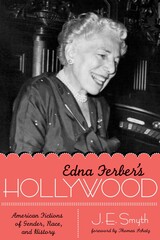 Edna Ferber's Hollywood: American Fictions of Gender, Race, and History
By J. E. Smyth
University of Texas Press, 2009 Edna Ferber's Hollywood reveals one of the most influential artistic relationships of the twentieth century—the four-decade partnership between historical novelist Edna Ferber and the Hollywood studios. Ferber was one of America's most controversial popular historians, a writer whose uniquely feminist, multiracial view of the national past deliberately clashed with traditional narratives of white masculine power. Hollywood paid premium sums to adapt her novels, creating some of the most memorable films of the studio era—among them Show Boat, Cimarron, and Giant. Her historical fiction resonated with Hollywood's interest in prestigious historical filmmaking aimed principally, but not exclusively, at female audiences. In Edna Ferber's Hollywood, J. E. Smyth explores the research, writing, marketing, reception, and production histories of Hollywood's Ferber franchise. Smyth tracks Ferber's working relationships with Samuel Goldwyn, Leland Hayward, George Stevens, and James Dean; her landmark contract negotiations with Warner Bros.; and the controversies surrounding Giant's critique of Jim-Crow Texas. But Edna Ferber's Hollywood is also the study of the historical vision of an American outsider—a woman, a Jew, a novelist with few literary pretensions, an unashamed middlebrow who challenged the prescribed boundaries among gender, race, history, and fiction. In a masterful film and literary history, Smyth explores how Ferber's work helped shape Hollywood's attitude toward the American past.
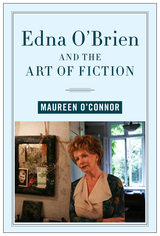 Edna O'Brien and the Art of Fiction
Maureen O'Connor
Bucknell University Press, 2022 Since the appearance of her first novel, The Country Girls, in 1960—a book that undermined the nation’s ideal of innocent and pious Irish girlhood—Edna O’Brien has provoked controversy in her native Ireland and abroad. Indeed, several of her early novels were condemned by church authorities and banned by the Irish government for their frank portrayals of sexual matters and the inner lives of women. Now an internationally acclaimed writer, O’Brien must be critically reassessed for a twenty-first century audience. Edna O’Brien and the Art of Fiction provides an urgent retrospective consideration of one of the English-speaking world’s best-selling and most prolific contemporary authors. Drawing on O’Brien’s fiction as well as archival material, and applying new theoretical approaches—including ecocritical and feminist new materialist readings—this study considers the pioneering and enduring ways O’Brien represents women’s experience, family relationships, the natural world, sex, creativity, and death, and her work’s long anticipation of contemporary movements such as #metoo.
Edom at the Edge of Empire: A Social and Political History
Bradley L. Crowell
SBL Press, 2021 A comprehensive history of a state on Judah’s border
Edom at the Edge of Empire combines biblical, epigraphic, archaeological, and comparative evidence to reconstruct the history of Judah's neighbor to the southeast. Crowell traces the material and linguistic evidence, from early Egyptian sources that recall conflicts with nomadic tribes to later Assyrian texts that reference compliant Edomite tribal kings, to offer alternative scenarios regarding Edom's transformation from a collection of nomadic tribes and workers in the Wadi Faynan as it relates to the later polity centered around the city of Busayra in the mountains of southern Jordan. This is the first book to incorporate the important evidence from the Wadi Faynan copper mines into a thorough account of Edom's history, providing a key resource for students and scholars of the ancient Near East and the Hebrew Bible.
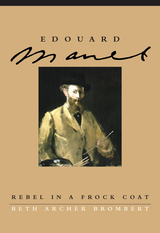 Edouard Manet: Rebel in a Frock Coat
Beth Archer Brombert
University of Chicago Press, 1997 "Manet comes alive in [Brombert's] pages. . . . At times her biography reads like a substantial and detailed 19th-century novel. . . . Brombert's Edouard Manet gives us not only a portrait of a complex artist but, in its authority and its range, a portrait of an age as well."—James R. Mellow, New York Times Book Review
"One of the pleasures of reading her is to follow the way she weaves life, art and history into a smooth tapestry. The art emerges from the life, and in the broadest possible context: in terms of its creator's life and concerns and in terns of its historical and cultural setting."—Eric Gibson, The Washington Times Books
"Richly detailed and informative . . . [this biography] exposes the character of an artist who maintained a sharply defined duality between his public and private personas."—Edward J. Sozanski, Philadelphia Inquirer
"Brombert's reading of important canvasses . . . shine, as do her accounts of the changing social and political environment in which Manet worked. . . . Well researched, complexly conceived, and clearly written."—Kirkus Reviews
"Brilliant . . . [this book] grants us a far deeper understanding of why [Manet's] paintings outraged so many of his peers, and why these same masterpieces resonate so richly in our psyches a century later."—Booklist, starred review
 Eduard C. Lindeman and Social Work Philosophy
Gisela Konopka
University of Minnesota Press, 1958 Eduard C. Lindeman and Social Work Philosophy was first published in 1958. Minnesota Archive Editions uses digital technology to make long-unavailable books once again accessible, and are published unaltered from the original University of Minnesota Press editions. Eduard C. Lindeman, a leader in the field of social work for many years, was deeply concerned with the profession's development of a basic philosophy. As a teacher at the New York School of Social Work for more than 25 years and as a prolific writer and consultant in a broad range of activities, Lindeman challenged old ideas and stimulated new ones in relation to the concepts and principles of social work. In this study of the man and his thinking, Mrs. Konopka, a professor of social work herself, provides an illuminated discussion of the theories upon which the practice of social work is based. In the first section Mrs. Konopka presents a biographical sketch of Lindeman, showing the forces and experiences which helped to shape his views and to create the ideas and ideals he fostered. Then she traces the development of Lindeman's philosophy over the three decades of his most fruitful period, the years from 1920 to 1953, when he died. In the third part, as a background for an understanding of Lindeman's contributions, she describes the status of social work values and goals before and during his career. In conclusion, she discusses a theory of social work based upon an integration of values, methods, and knowledge. This book will be especially useful to those teaching courses in the history and philosophy of social work and related professions, as well as to those actively engaged in social work.
Eduardo Balderas: Father of Church Translation, 1907-1989
Ignacio M. Garcia
Signature Books, 2024 Eduardo Balderas: Father of Church Translation tells the story of a child refugee from Mexico whose family came to live in Texas in the 1900s. There he joined the Church of Jesus Christ of Latter-day Saints, served a mission, became a branch president, and began translating for the church. He went on to translate the Pearl of Great Price, the Doctrine and Covenants, Jesus the Christ, church manuals, and the temple ceremony. He also founded the Spanish-language Liahona magazine, helped establish the church translation department, and served as a patriarch for Latinos in the US and other parts of the Spanish-speaking world.
 Eduardo Halfon and the Itinerary of Memory
Marilyn G. Miller
Vanderbilt University Press, 2024 Arguably, all of Guatemalan writer Eduardo Halfon’s fictional works deal with quandaries of translation, even in their original versions. The award-winning author of fifteen books claims to have lost his mother tongue when his family fled to the United States after his tenth birthday. This displacement, echoing the displacement of his four grandparents from different corners of the Jewish diaspora to Guatemala, gives Halfon, like his ancestors before him, good reason to consider translation a natural environment for his creative work and for life itself. Indeed, Halfon’s uncanny ability to translate his family’s history into “fictions” that resonate across the globe with readers in Spanish, English, and several other languages helps explain why he has received numerous prizes in the United States, Spain, Guatemala, and even France, some as a Latin American author, others as a Latino or Jewish author.
Marilyn G. Miller has written the first study to focus exclusively on this important voice in Jewish–Latin American letters. Only after returning to Guatemala and regaining his command of Spanish through reading literature did Halfon begin to build his life as a writer and translator. Nonetheless, the author admits that “one thing is stubbornly true, and it’s this: every sentence that I write, every verb or adjective that I painstakingly insert or remove, every literary thought that I have while writing, always . . . begins and ends in English.” Halfon’s translated works are never parallel texts, however. Thus, translation and its side effects (foreign words, linguistic lacunae, multilingual modes of perception) offer us crucial keys to understanding the author’s fictional world as a vehicle for retelling and surviving Jewish trauma and finding his own particular plurilingual voice.
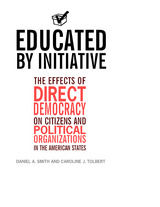 Educated by Initiative: The Effects of Direct Democracy on Citizens and Political Organizations in the American States
Daniel A. Smith and Caroline J. Tolbert
University of Michigan Press, 2004 "This body of research not only passes academic muster but is the best guidepost in existence for activists who are trying to use the ballot initiative process for larger policy and political objectives."
--Kristina Wilfore, Executive Director, Ballot Initiative Strategy Center and Foundation Educated by Initiative moves beyond previous evaluations of public policy to emphasize the educational importance of the initiative process itself. Since a majority of ballots ultimately fail or get overturned by the courts, Smith and Tolbert suggest that the educational consequences of initiative voting may be more important than the outcomes of the ballots themselves. The result is a fascinating and thoroughly-researched book about how direct democracy teaches citizens about politics, voting, civic engagement and the influence of special interests and political parties. Designed to be accessible to anyone interested in the future of American democracy, the book includes boxes (titled "What Matters") that succinctly summarize the authors' data into easily readable analyses. Daniel A. Smith is Associate Professor of Political Science at the University of Florida. Caroline J. Tolbert is Associate Professor of Political Science at Kent State University.
The Educated Eye: Visual Culture and Pedagogy in the Life Sciences
Edited by Nancy Anderson
Dartmouth College Press, 2012 The creation and processing of visual representations in the life sciences is a critical but often overlooked aspect of scientific pedagogy. The Educated Eye follows the nineteenth-century embrace of the visible in new spectatoria, or demonstration halls, through the twentieth-century cinematic explorations of microscopic realms and simulations of surgery in virtual reality. With essays on Doc Edgerton’s stroboscopic techniques that froze time and Eames’s visualization of scale in Powers of Ten, among others, contributors ask how we are taught to see the unseen.
Educated in Romance: Women, Achievement, and College Culture
Dorothy C. Holland and Margaret A. Eisenhart
University of Chicago Press, 1990 Is romance more important to women in college than grades are? Why do so many women enter college with strong academic backgrounds and firm career goals but leave with dramatically scaled-down ambitions? Dorothy C. Holland and Margaret A. Eisenhart expose a pervasive "culture of romance" on campus: a high-pressure peer system that propels women into a world where their attractiveness to men counts most.
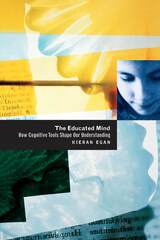 The Educated Mind: How Cognitive Tools Shape Our Understanding
Kieran Egan
University of Chicago Press, 1997 The Educated Mind offers a bold and revitalizing new vision for today's uncertain educational system. Kieran Egan reconceives education, taking into account how we learn. He proposes the use of particular "intellectual tools"—such as language or literacy—that shape how we make sense of the world. These mediating tools generate successive kinds of understanding: somatic, mythic, romantic, philosophical, and ironic. Egan's account concludes with practical proposals for how teaching and curriculum can be changed to reflect the way children learn.
"A carefully argued and readable book. . . . Egan proposes a radical change of approach for the whole process of education. . . . There is much in this book to interest and excite those who discuss, research or deliver education."—Ann Fullick, New Scientist
"A compelling vision for today's uncertain educational system."—Library Journal
"Almost anyone involved at any level or in any part of the education system will find this a fascinating book to read."—Dr. Richard Fox, British Journal of Educational Psychology
"A fascinating and provocative study of cultural and linguistic history, and of how various kinds of understanding that can be distinguished in that history are recapitulated in the developing minds of children."—Jonty Driver, New York Times Book Review
 Educated Out: How Rural Students Navigate Elite Colleges—And What It Costs Them
Mara Casey Tieken
University of Chicago Press, 2025 Through the stories of nine rural, first-generation students and their families, Educated Out shows how geography shapes college opportunities, from admission to postgraduation options.
A former third-grade teacher in rural Tennessee, education researcher Mara Casey Tieken watched as her former students graduated high school. She was shocked at how few were heading to college—and none were going to elite four-year schools. These students were representative of a larger national phenomenon: In 2021, 31 percent of rural adults aged twenty-five and older held a postsecondary degree, compared to 45 percent of urban adults, and rural students are especially unlikely to pursue degrees from private, selective schools. Why, Tieken wondered? And what happens to the handful of rural students who do attend elite colleges, colleges that may feel worlds away from home?
Tieken addresses these questions in Educated Out—a study that shows how geography shapes rural, first-generation students’ access to college, their college experiences, and their postgraduation plans and opportunities. Tieken closely follows a group of nine students for their college years and beyond at an elite New England private school that she calls Hilltop. Interviews with these students reveal the critical moments in the students’ educational careers when their rural origins mattered most: when applying to college, she shows how students are hindered by limited college counseling resources. Once on campus, they learn that many of the school’s opportunities are not available to them: they cannot access spring break trips, job networks, or low-pay-but-important internships. These students discover that home and college are very different worlds with different academic, social, and political climates—and, over time, they start to question both. As they near graduation and navigate a job market in which the highest-paying and most prestigious opportunities are located in urban centers, they begin to feel the complicated burden of their schooling: they’ve been “educated out.” Their stories show the costs of college for rural students: If they do not pursue higher education, they lose the opportunity for social mobility; if they do, they face a more permanent departure. These costs are individual, but rural families and communities also suffer—they lose young people with talent and skills.
In addition to advocating for a higher education landscape that truly includes rural students, Tieken critiques a system that requires people to leave their rural homes in search of opportunities. Our current economy depends on inexpensive rural labor. Without meaningful change, some students will have to make the impossible decision to leave home—and far more will remain there, undereducated and overlooked.
Both engaging and accessible, Educated Out presents important and timely questions about rurality, identity, education, and inequality.
 Educated Out: How Rural Students Navigate Elite Colleges—And What It Costs Them
Mara Casey Tieken
University of Chicago Press, 2025 This is an auto-narrated audiobook version of this book.
Through the stories of nine rural, first-generation students and their families, Educated Out shows how geography shapes college opportunities, from admission to postgraduation options.
A former third-grade teacher in rural Tennessee, education researcher Mara Casey Tieken watched as her former students graduated high school. She was shocked at how few were heading to college—and none were going to elite four-year schools. These students were representative of a larger national phenomenon: In 2021, 31 percent of rural adults aged twenty-five and older held a postsecondary degree, compared to 45 percent of urban adults, and rural students are especially unlikely to pursue degrees from private, selective schools. Why, Tieken wondered? And what happens to the handful of rural students who do attend elite colleges, colleges that may feel worlds away from home?
Tieken addresses these questions in Educated Out—a study that shows how geography shapes rural, first-generation students’ access to college, their college experiences, and their postgraduation plans and opportunities. Tieken closely follows a group of nine students for their college years and beyond at an elite New England private school that she calls Hilltop. Interviews with these students reveal the critical moments in the students’ educational careers when their rural origins mattered most: when applying to college, she shows how students are hindered by limited college counseling resources. Once on campus, they learn that many of the school’s opportunities are not available to them: they cannot access spring break trips, job networks, or low-pay-but-important internships. These students discover that home and college are very different worlds with different academic, social, and political climates—and, over time, they start to question both. As they near graduation and navigate a job market in which the highest-paying and most prestigious opportunities are located in urban centers, they begin to feel the complicated burden of their schooling: they’ve been “educated out.” Their stories show the costs of college for rural students: If they do not pursue higher education, they lose the opportunity for social mobility; if they do, they face a more permanent departure. These costs are individual, but rural families and communities also suffer—they lose young people with talent and skills.
In addition to advocating for a higher education landscape that truly includes rural students, Tieken critiques a system that requires people to leave their rural homes in search of opportunities. Our current economy depends on inexpensive rural labor. Without meaningful change, some students will have to make the impossible decision to leave home—and far more will remain there, undereducated and overlooked.
Both engaging and accessible, Educated Out presents important and timely questions about rurality, identity, education, and inequality.
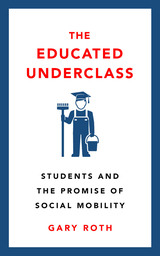 The Educated Underclass: Students and the False Promise of Social Mobility
Gary Roth
Pluto Press, 2019 "The waste of human capacity Roth describes is phenomenal. But his major point is that it is not new. The millennials are feeling the worst of it, perhaps, but only the worst so far."—Inside High Ed
The dream of social mobility is dying. Where previous generations routinely expected to surpass their parents' level of economic success, prospects for today's young people are increasingly bleak. What role does higher education play in the process? An essential and frightening one, according to author Gary Roth.
The Educated Underclass reveals the structural problems that are helping to create this problem. Gary Roth shows how universities—touted as the best way up the economic ladder for young people—actually reproduce traditional class hierarchies. And as more graduates emerge every year into economies that are no longer creating a steady stream of stable jobs, the odds of landing one decrease—and over-educated people end up scrapping for poorly compensated positions for which they're overqualified. Chapters include:
*Higher education and class
*The overproduction of intelligence
*Class in transition: historical background
*Underemployment through the decades
*Class status and economic instability
*And more!
Roth writes in his Introduction, “Education has become an intermediary institution between a social system that habitually sputters and declines while ever-greater amounts of consumer products are dangled in front of the system’s workforce. The result: a dynamic fraught with all sort of negative possibilities, both socially and psychotically.”
A broadside against the failures of our education system and our economy, Gary Roth’s The Educated Underclass aims to startle us out of our complacency and wake us up to action.
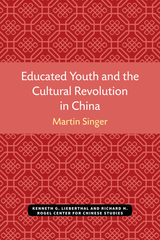 Educated Youth and the Cultural Revolution in China
Martin Singer
University of Michigan Press, 1971 The Cultural Revolution was an emotionally charged political awakening for the educated youth of China. Called upon by aging revolutionary Mao Tse-tung to assume a “vanguard” role in his new revolution to eliminate bourgeois revisionist influence in education, politics, and the arts, and to help to establish proletarian culture, habits, and customs, in a new Chinese society, educated young Chinese generally accepted this opportunity for meaningful and dramatic involvement in Chinese affairs. It also gave them the opportunity to gain recognition as a viable and responsible part of the Chinese polity. In the end, these revolutionary youths were not successful in proving their reliability. Too “idealistic” to compromise with the bourgeois way, their sense of moral rectitude also made it impossible for them to submerge their factional differences with other revolutionary mass organizations to achieve unity and consolidate proletarian victories. Many young revolutionaries were bitterly disillusioned by their own failures and those of other segments of the Chinese population and by the assignment of recent graduates to labor in rural communes. Educated Youth and the Cultural Revolution in China reconstructs the events of the Cultural Revolution as they affected young people. Martin Singer integrates material from a range of factors and effects, including the characteristics of this generation of youths, the roles Mao called them to play, their resentment against the older generation, their membership in mass organizations, the educational system in which they were placed, and their perception that their skills were underutilized. To most educated young people in China, Singer concludes, the Cultural Revolution represented a traumatic and irreversible loss of political innocence, made yet more tragic by its allegiance to the unsuccessful campaign of an old revolutionary to preserve his legacy from the inevitable storms of history.
 Educating a Diverse Nation: Lessons from Minority-Serving Institutions
Clifton Conrad and Marybeth Gasman
Harvard University Press, 2015 In an increasingly diverse United States, minority and low-income students of all ages struggle to fit into mainstream colleges and universities that cater predominantly to middle-income and affluent white students fresh out of high school. Anchored in a study conducted at twelve minority-serving institutions (MSIs), Educating a Diverse Nation turns a spotlight on the challenges facing nontraditional college students and highlights innovative programs and practices that are advancing students’ persistence and learning.
Clifton Conrad and Marybeth Gasman offer an on-the-ground perspective of life at MSIs. Speaking for themselves, some students describe the stress of balancing tuition with the need to support families. Others express their concerns about not being adequately prepared for college-level work. And more than a few reveal doubts about the relevance of college for their future. The authors visited the four main types of MSIs—historically black colleges and universities, tribal colleges and universities, Hispanic-serving institutions, and Asian American and Native American Pacific Islander–serving institutions—to identify strategies for empowering nontraditional students to succeed in college despite these obstacles.
Educating a Diverse Nation illuminates such initiatives as collaborative learning, culturally relevant educational programs, blurring the roles of faculty, staff, and students, peer-led team learning, and real-world problem solving. It shows how these innovations engage students and foster the knowledge, skills, and habits they need to become self-sustaining in college and beyond, as well as valuable contributors to society.
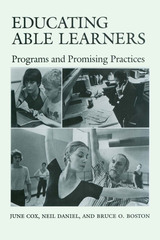 Educating Able Learners: Programs and Promising Practices
By June Cox, Neil Daniel, and Bruce O. Boston
University of Texas Press, 1985 American education has long been under a microscope. In a time when all aspects of our school system face close scrutiny, educators, administrators, and parents are asking critical questions about how we educate those superior students we call “able learners.”
Our schools reward behavior inappropriate for an independent thinker, researcher, or artist. Programming for our most capable students is fragmented and discontinuous. And yet there are schools and programs that hold significant promise.
This four-year national study from the Sid W. Richardson Foundation provides a broad database, looks into the backgrounds of a few unusually creative individuals, and examines programs with a record of success. It argues in favor of comprehensive programming for able learners, providing a steady challenge for all students, helping to insure that no individual talent withers for want of opportunity. Included are recommendations for discovering and nurturing talent in students (including traditionally neglected groups, the economically disadvantaged, and the culturally diverse), building and administering sound programs, developing appropriately trained staff and teachers, and evaluating effectiveness of programs to assure accountability and add credibility.
Compiling data from diverse sources—including 35 MacArthur Foundation Fellows, 400 schools, 1,172 school districts, and countless school personnel and students—the study looks at programs for able learners throughout the country, from Project Pegasus in Iowa to Oaks Academy in Texas, from Bronx High School of Science in New York to Bishop Carroll High School in Alberta, Canada. The authors’ conclusions based on this broad investigation provide an impassioned call for coordinated schooling and cooperation among all segments of society to develop a new generation of creative, self-motivated students.
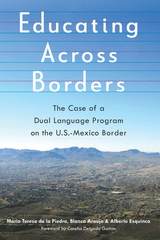 Educating Across Borders: The Case of a Dual Language Program on the U.S.-Mexico Border
María Teresa de la Piedra, Blanca Araujo, and Alberto Esquinca; Foreword by Concha Delgado Gaitan
University of Arizona Press, 2018 Educating Across Borders is an ethnography of the learning experiences of transfronterizxs, border-crossing students who live on the U.S.-Mexico border, their lives spanning two countries and two languages. Authors María Teresa de la Piedra, Blanca Araujo, and Alberto Esquinca examine language practices and funds of knowledge these students use as learning resources to navigate through their binational, dual language school experiences.
The authors, who themselves live and work on the border, question artificially created cultural and linguistic borders. To explore this issue, they employed participant-observation, focus groups, and individual interviews with teachers, administrators, and staff members to construct rich understandings of the experiences of transfronterizx students. These ethnographic accounts of their daily lives counter entrenched deficit perspectives about transnational learners.
Drawing on border theory, immigration and border studies, funds of knowledge, and multimodal literacies, Educating Across Borders is a critical contribution toward the formation of a theory of physical and metaphorical border crossings that ethnic minoritized students in U.S. schools must make as they traverse the educational system.
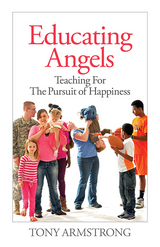 Educating Angels: Teaching for the Pursuit of Happiness
Tony Armstrong, Ph.D
Parkhurst Brothers, Inc., 2013 School reform and accountability tests have been hotly debated for decades, but the goal of reform and accountability has not. Most agree that the main problem with contemporary education is that it fails to adequately prepare students with the “21st century skills” needed to find jobs and promote national competitiveness in the global economy. Tony Armstrong challenges both the morality and the consequences of pushing this purpose of education. He says it is immoral because it neglects our children’s deepest aspiration—happiness—and treats them as mere cogs in the economic machine. Dr. Armstrong shows how methods of well-being based on happiness research—mindfulness, gratitude, perspective—can greatly improve kids’ chances to feel better in the present and to live happier lives in the future. And the kindergarten-through-college “happiness pedagogy” he presents would also be a superior way to teach those “21st century skills.”
 Educating Artists for the Future: Learning at the Intersections of Art, Science, Technology, and Culture
Edited by Mel Alexenberg
Intellect Books, 2008 In Educating Artists for the Future, some of the world’s most innovative thinkers about higher education in the arts offer fresh directions for educating artists and designers for a post-digital future. A group of artists, researchers, and teachers from a dozen countries here redefine art at the interdisciplinary interface where scientific inquiry and new technologies shape aesthetic values. This volume offers groundbreaking guidelines for art educators, demonstrating how the interplay between digital and cultural systems calls for alternative pedagogical strategies that encourage student-centered interactive learning. “Mel Alexenberg, a very sophisticated artist and scholar of much experience in the complex playing field of art-science-technology, addresses the rarely asked question: How does the ‘media magic’ communicate content?”—Otto Piene, Professor Emeritus and Director, Center for Advanced Visual Studies, Massachusetts Institute of Technology
Educating At-Risk Students
Edited by Sam Stringfield and Deborah Land
University of Chicago Press, 2002 This volume focuses on both the background causes that place students "at risk" and specific strategies that have been shown to help address students' academic risk. Various chapters cover such key topics as the extent and consequences of risk in U.S. education, resiliency among at-risk students, the effectiveness of various interventions at reducing risk, and systemic supports for overcoming educational risk. Issues in the educating of African American, Hispanic, and second-language learning students are each discussed, as well as Title I, technology education, and professional development in high poverty contexts.
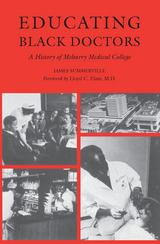 Educating Black Doctors: A History of Meharry Medical College
James Summerville
University of Alabama Press, 1984 A journalistic, well-documented account of varying approaches to improving health for Black Americans
Fr one hundred years, Meharry has provided opportunity to thousands of Black Americans and some others, but the history of the institution is told, not by the changes in the futures of those fortunate men and women who became graduates, but by the action of a few in each generation with the vision to attack the vestiges of slavery, poverty, and excess morbidity through the building and operation of a medical college.
The college was conceived just after the Civil War when many thought the problem of the ex-slaves would soon disappear because their death rate was so great and the absence of health care was not a focus. The institution would be national, but its setting was a bankrupt city that had the fourth worst health statistics in the world. It was started by a missionary who had no money or medical experience at a time when there were more who objected to this work than applauded it. However, the desire of those students who begged that a medical school be started and the future of the many people who would be touched by its services were enough to motivate the founders to embark on this venture.
A number of documents have existed chronicling the events of the institution, but when requested by an academic society to provide one book that gave the most accurate history of the institution, I knew that no recent such book had been written. This book satisfies the need for such facts to be available. It also provides a journalistic, well-documented account of the varying approaches to providing opportunity and improving health for Black Americans.
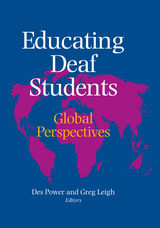 Educating Deaf Students: Global Perspectives
Des Power
Gallaudet University Press, 2005 The 19th International Congress on Education of the Deaf (ICED) in 2000, held in Sydney, Australia, brought together 1,067 teachers, administrators and researchers from 46 countries to address an extremely wide selection of topics. Experts from around the world discussed inclusion of deaf students in regular educational environments, literacy, audiology, auditory development and listening programs, hearing aids, programming for children with cochlear implants, signed communication in education, bilingual education, early intervention (including the rapidly emerging area of newborn hearing screening), education in developing countries, deaf students with multiple disabilities, and deaf students in post-secondary school education.
The 19 chapters of Educating Deaf Students: Global Perspectives present a select cross-section of the issues addressed at the 19th ICED. Divided into four distinct parts – Contemporary Issues for all Learners, The Early Years, The School Years, and Contemporary Issues in Postsecondary Education – the themes considered here span the entire student age range. Authored by 27 different researchers and practitioners from six different countries, this book can be seen as a valuable description of the zeitgeist in the field of education of the deaf at the turn of the 21st century and the millennium.
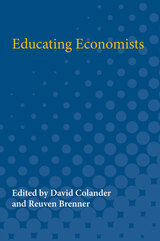 Educating Economists
David Colander and Reuven Brenner, Editors
University of Michigan Press, 1992 What should economists learn in undergraduate and graduate programs? And how does this differ from what students are being taught?In a series of provocative essays, the contributors to Educating Economists cast a critical eye upon the profession and offer solutions to the serious problems they identify in contemporary economics education.The failure of economics teaching is the theme that connects all of the papers in this volume: the failure to develop the skills needed by undergraduate teachers of economics and the failure to prepare students to do work in government and business.The authors point out that professors have lost sight of the skills needed to deal with real-world data, to gain access to existing knowledge, and to critically examine issues, models, and data. Instead, they argue, tenure-minded graduate professors, focused on the use of high-powered mathematical techniques to write formal, technical articles, prepare students only to do abstract research within a framework that just a few other fellow graduates can understand. This situation results in the systematic degradation of the quality of undergraduate economics education and of the institutional usefulness of economics.The contributors conclude that a substantial restructuring of economics education and of the economics profession, including its tenure requirements, is needed and would allow the discipline—and its practitioners—to make a much stronger and more relevant contribution to the people and institutions whose behavior it attempts to explain.
Educating English Daughters: Late Seventeenth-Century Debates
Bathsua Makin and Mary More
Iter Press, 2016 This edition offers texts from Bathsua Makin and Mary More, and Robert Whitehall’s response to More’s argument. Makin describes the appropriate education for London merchants’ daughters, arguing that girls should be educated and should aspire to follow learned women in history, and that educated women improve their families and themselves. More argues that women have the right to an education, and that such an education shows that the inequality of married women under English law is a man-made institution. More’s argument drew objections from her Oxford reader, Robert Whitehall, who preserved her manuscript with his own. Makin and More enjoyed a measure of public recognition and esteem, yet after their deaths, they and their texts were largely ignored until the late twentieth century.
Educating Film-Makers: Past, Present and Future
Duncan Petrie and Rod Stoneman
Intellect Books, 2014 A timely consideration of both the history and the current challenges facing practice-based film training, Educating Film-Makers is the first book to examine the history, impact, and significance of film education in Britain, Europe, and the United States. Film schools, the authors show, have historically focused on the cultivation of the filmmaker as a cultural activist, artist, or intellectual – fostering creativity and innovation. But more recently a narrower approach has emerged, placing a new emphasis on technical training for the industry. The authors argue for a more imaginative engagement and understanding of the broader social importance of film and television, suggesting that critical analysis and production should be connected. Examining current concerns facing practice-based film education in the digital era, this book is indispensable for film teachers and students alike.
 Educating for Advanced Foreign Language Capacities: Constructs, Curriculum, Instruction, Assessment
Heidi Byrnes, Heather D. Weger-Guntharp, and Katherine A. Sprang, Editors
Georgetown University Press, 2006 Advanced language learning has only recently begun to capture the interest and attention of applied linguists and professionals in language education in the United States. In this breakthrough volume, experts in the field lay the groundwork for approaching the increasingly important role of advanced language learning in the larger context of multilingual societies, globalization, and security. This volume presents both general and theoretical insights and language-specific considerations in college classrooms spanning a range of languages, from the commonly taught languages of English, French, and German to the less commonly taught Farsi, Korean, Norwegian, and Russian. Among theoretical frameworks likely to be conducive to imagining and fostering instructed "advancedness" in a second language, this volume highlights a cognitive-semantic approach. The theoretical and data-based findings make clear that advanced learners in particular are characterized by the capacity to make situated choices from across the entire language system, from vocabulary and grammar to discourse features, which suggests the need for a text-oriented, meaning-driven approach to language teaching, learning, and research. This volume also considers whether and how information structuring in second-language composition reveals first-language preferences of grammaticized concepts. Other topics include curricular and instructional approaches to narrativity, vocabulary expansion, the demands on instructed programs for efficiency and effectiveness in order to assure advanced levels, and learners' ability to function in professional contexts with their diverse oral and written genre requirements. Finally, the volume probes the role and nature of assessment as a measurement tool for both researching and assessing advanced language learning and as an essential component of improving programs.
Educating for Professional Life: Twenty-five Years of the University of Westminster
Elaine Penn
University of Westminster Press, 2017 The story of the University of Westminster is the fifth volume in a series of titles exploring the University's long and diverse history. This book celebrates the twenty-fifth anniversary of the institution gaining university status, the right to award its own degrees and to participate in publicly funded research. Drawing on extensive research conducted in the University of Westminster Archive this volume investigates the evolution from Polytechnic to University within the broader context of the transformation of UK higher education in the late twentieth and early twenty-first centuries.
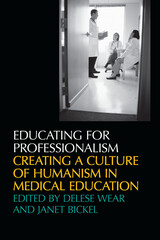 Educating For Professionalism: Creating A Culture Of Humanism In Medical Education
Delese Wear
University of Iowa Press, 2000 The thirteen essays in Educating for Professionalism examine the often conflicting ethical, social, emotional, and intellectual messages that medical institutions send to students about what it means to be a doctor. Because this disconnection between what medical educators profess and what students experience is partly to blame for the current crisis in medical professionalism, the authors offer timely, reflective analyses of the work and opportunities facing medical education if doctors are to win public trust. In their drive to improve medical professionalism within the world of academic medicine, editors Delese Wear and Janet Bickel have assembled thought-provoking essays that elucidate the many facets of teaching, valuing, and maintaining medical professionalism in the middle of the myriad challenges facing medicine at the dawn of the twenty-first century. The collection traces how the values of altruism and service can influence not only mission statements and admission policies but also the content of medical school ethics courses, student-led task forces, and mentoring programs, along with larger environmental issues in medical schools and the communities they serve. Contributors: Stanley Joel Reiser
Jack Coulehan
Peter C. Williams
Frederic W. Hafferty
Richard Martinez
Judith Andre
Jake Foglio
Howard Brody
Sheila Woods
Sue Fosson
Lois Margaret Nora
Mary Anne C. Johnston
Tana A. Grady-Weliky
Cynthia N. Kettyle
Edward M. Hundert
Norma E. Wagoner
Frederick A. Miller
William D. Mellon
Howard Waitzkin
Donald Wasylenki
Niall Byrne
Barbara McRobb
Edward J. Eckenfels
Lucy Wolf Tuton
Claudia H. Siegel
Timothy B. Campbell
 Educating for Virtue
Joseph Baldacchino
American Philanthropic, 1988
In Educating for Virtue, five scholars address one of the most pressing issues of our time: the relationship between education and the development of moral character. With essays by Claes G. Ryn, Russell Kirk, Paul Gottfried, Peter J. Stanlis, Solveig Eggerz.
From the Foreword:
“If there is a single thread that runs through these essays, it is the recognition of a universal order that transcends the flux of human life and gives meaning to it. Insofar as men act in accordance with this order, they experience true happiness and are brought into community with others who are similarly motivated. But men are afflicted with contrary impulses that are destructive of universal order. When acted upon, these impulses bring suffering and a sense of meaninglessness and despair; the result is disintegration and conflict--within both the personality and society at large. Yet so tempting are the attactions of these impulses that they frequently prevail and must be taken into account in any realistic assessment of human affairs. This tension within the person between competing desires--the conflict between what Plato called the One and the Many--is the ultimate reality of human experience. To apprehend this reality, and to act in the light of the transcendent purpose with appropriate reverence and restraint, is the essence of wisdom; and to help deepen and strengthen this apprehension--through philosophy, history, literature, and the arts and sciences--is the overarching purpose of any education worthy of the name.”
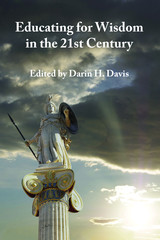 Educating for Wisdom in the 21st Century
Darin H. Davis
St. Augustine's Press, 2019 Contemporary higher education is in the midst of undeniable challenge and transformation. The cost of a college degree continues to increase by leaps and bounds as many students and their parents assume enormous student loan debt. Sweeping technological change, especially online instruction, is now forcing colleges and universities to re-envision how course content can be offered. Moreover, it is not clear what people expect colleges and universities to do in the first place. Should they be primarily devoted to preparing their graduates to enter the workforce? Should they at the same time advance innovative research across the disciplines in ways that expand the frontiers of knowledge? Should they seek to form their students intellectually, morally, and even spiritually, while preparing them for responsible citizenship and civic engagement? Should they also be the places where enthusiastic sports fans gather in grand arenas and stadiums to watch athletes pursue victory? A generation ago it was generally believed that the essential purpose of a university education was educating for wisdom — shaping the moral and intellectual character of students in ways that led them to live and do well over their entire lives. Although the mission statements and curricula of many small, private liberal arts colleges and even large state-supported universities still echo this commitment, it is by no means the defining mark of present day higher education. The contributors to this volume — which include some of the most thoughtful critics of the modern academy —contend that seeking, teaching, and cultivating wisdom remains the fundamental aim of university education. Neither lamenting the current state of affairs nor waxing nostalgic for bygone days, the authors in this volume reflect upon the nature of wisdom, its sources, and how it again might animate teaching and learning in 21st century. With essays from Anthony Kronman, Andrew Delbanco, Darin Davis, Celia Deane-Drummond, John Haldane, and Walter Brueggemann, this volume brings together a distinguished and diverse group of voices to consider this timely and important topic.
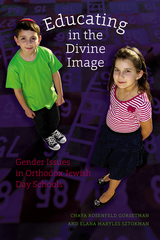 Educating in the Divine Image: Gender Issues in Orthodox Jewish Day Schools
Chaya Rosenfeld Gorsetman and Elana Maryles Sztokman
Brandeis University Press, 2013 Although recent scholarship has examined gender issues in Judaism with regard to texts, rituals, and the rabbinate, there has been no full-length examination of the education of Jewish children in day schools. Drawing on studies in education, social science, and psychology, as well as personal interviews, the authors show how traditional (mainly Orthodox) day school education continues to re-inscribe gender inequities and socialize students into unhealthy gender identities and relationships. They address pedagogy, school practices, curricula, and textbooks, as along with single-sex versus coed schooling, dress codes, sex education, Jewish rituals, and gender hierarchies in educational leadership. Drawing a stark picture of the many ways both girls and boys are molded into gender identities, the authors offer concrete resources and suggestions for transforming educational practice.
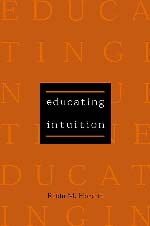 Educating Intuition
Robin M. Hogarth
University of Chicago Press, 2001 Every day we make intuitive decisions—from the mundane choice of what clothes to wear to more important issues such as which new car "feels right" or which person would be "good" for a particular job. To varying degrees, logic plays a role in these decisions, but at a certain point all of us rely on intuition, our sixth sense. Is this the right way to decide? Should we trust our gut feelings? When intuition conflicts with logic, what should we do?
In Educating Intuition, Robin M. Hogarth lays bare this mysterious process so fundamental to daily life by offering the first comprehensive overview of what the science of psychology can tell us about intuition—where it comes from, how it works, whether we can trust it. From this literature and his own research, Hogarth finds that intuition is a normal and important component of thought that has its roots in processes of tacit learning. Environment, attention, experience, expertise, and the success of the scientific method all form part of Hogarth's perspective on intuition, leading him to the surprising—but natural—conclusion that we can educate our sixth sense. To this end he offers concrete suggestions and exercises to help readers develop their intuitive skills and habits for learning the "right" lessons from experience.
Artfully and accessibly combining cognitive science, the latest research in psychology, and Hogarth's own observations, Educating Intuition eschews the vague approach to the topic that has become commonplace and provides instead a wholly engaging and practical guide to enhancing our intuitive skills.
 Educating Medical Teachers
George E. Miller
Harvard University Press, 1980 Educating Medical Teachers explores the history of educational research programs for the health professions since 1955, when the first Project in Medical Education was initiated at the University of Buffalo. With characteristic wit and with the unique perspective of his central position in this field, George Miller describes the evolution and vicissitudes of educational research units and their impact on the medical establishment. Miller also traces the trend in educational research away from a narrow concern with pedagogical problems to a reexamination of the purpose and direction of the medical school itself. He sees a major role for educational research in accommodating the concurrent societal demands for academic excellence and for a more efficient healthcare delivery system, but he argues that, to be effective, educationists must first enhance their own prestige within the medical community. Miller's analysis of past failures makes a sound case for the prescriptions of his concluding chapter.
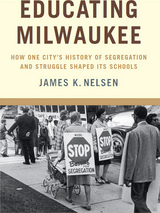 Educating Milwaukee: How One City’s History of Segregation and Struggle Shaped Its Schools
James K. Nelsen
Wisconsin Historical Society Press, 2015 "Milwaukee's story is unique in that its struggle for integration and quality education has been so closely tied to [school] choice." --from the Introduction "Educating Milwaukee: How One City's History of Segregation and Struggle Shaped Its Schools" traces the origins of the modern school choice movement, which is growing in strength throughout the United States. Author James K. Nelsen follows Milwaukee's tumultuous education history through three eras--"no choice," "forced choice," and "school choice." Nelsen details the whole story of Milwaukee's choice movement through to modern times when Milwaukee families have more schooling options than ever--charter schools, open enrollment, state-funded vouchers, neighborhood schools--and yet Milwaukee's impoverished African American students still struggle to succeed and stay in school. "Educating Milwaukee" chronicles how competing visions of equity and excellence have played out in one city's schools in the modern era, offering both a cautionary tale and a "choice" example.
Educating Mind, Body and Spirit: The legacy of Quintin Hogg and The Polytechnic, 1864-1992
Helen Glew, Anthony Gorst, Michael Heller and Neil Matthews
University of Westminster Press, 2013 The story of the Polytechnic and of the legacy of Quintin Hogg is the third publication exploring the University of Westminster's long and diverse history. A fitting tribute to the life and legacy of Hogg, his holistic approach to education and the institute he created. This book is richly illustrated with images from the University's Archive.
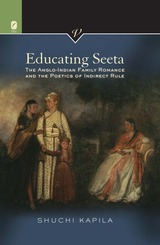 Educating Seeta: The Anglo-Indian Family Romance and the Poetics of Indirect Rule
Shuchi Kapila
Ohio State University Press, 2010 Even though Edward Said’s Orientalism inspired several generations of scholars to study the English novel’s close involvement with colonialism, they have not considered how English novels themselves were radically altered by colonialism. In Educating Seeta, Shuchi Kapila argues that the paradoxes of indirect rule in British India were negotiated in “family romances” which encoded political struggle in the language of domestic and familial civility. A mixture of domestic ideology and liberal politics, these are Anglo-Indian romances, written by British colonials who lived in India during a period of indirect colonial rule. Instead of providing neat conclusions and smooth narratives, they become a record of the limits of liberal colonialism. They thus offer an important supplement to Victorian novels, extend the study of nineteenth-century domestic ideology, and offer a new perspective on colonial culture. Kapila demonstrates that popular writing about India and, by implication, other colonies is an important supplement to the high Victorian novel and indispensable to our understanding of nineteenth-century English literature and culture. Her nuanced study of British writing about indirect rule in India will reshape our understanding of Victorian domestic ideologies, class formation, and gender politics.
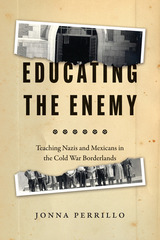 Educating the Enemy: Teaching Nazis and Mexicans in the Cold War Borderlands
Jonna Perrillo
University of Chicago Press, 2022 Compares the privileged educational experience offered to the children of relocated Nazi scientists in Texas with the educational disadvantages faced by Mexican American students living in the same city. Educating the Enemy begins with the 144 children of Nazi scientists who moved to El Paso, Texas, in 1946 as part of the military program called Operation Paperclip. These German children were bused daily from a military outpost to four El Paso public schools. Though born into a fascist enemy nation, the German children were quickly integrated into the schools and, by proxy, American society. Their rapid assimilation offered evidence that American public schools played a vital role in ensuring the victory of democracy over fascism. Jonna Perrillo not only tells this fascinating story of Cold War educational policy, but she draws an important contrast with another, much more numerous population of children in the El Paso public schools: Mexican Americans. Like everywhere else in the Southwest, Mexican American children in El Paso were segregated into “Mexican” schools, where the children received a vastly different educational experience. Not only were they penalized for speaking Spanish—the only language all but a few spoke due to segregation—they were tracked for low-wage and low-prestige careers, with limited opportunities for economic success. Educating the Enemy charts what two groups of children—one that might have been considered the enemy, the other that was treated as such—reveal about the ways political assimilation has been treated by schools as an easier, more viable project than racial or ethnic assimilation. Listen to an interview with the author here and read an interview in Time and a piece based on the book in the Boston Review.
Educating the Masses: The Unfolding History of Black School Administrators in Arkansas, 1900-2000
C. Calvin Smith
University of Arkansas Press, 2003 Under segregation and in its aftermath, black teachers and principals created havens of dignity and uplift for their students and communities. In Arkansas, where even education for white children has always been underfunded, the work of these administrators has been particularly heroic. This book, researched and prepared by the Research Committee of the Retired Educators of Little Rock and Other Public Schools, outlines the challenges to generations of black administrators in the state, and it maps their achievements. It also offers the first reference guide to the personnel who have educated generations of black children through the most extreme of circumstances.
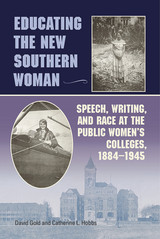 Educating the New Southern Woman: Speech, Writing, and Race at the Public Women's Colleges, 1884-1945
David Gold and Catherine L. Hobbs
Southern Illinois University Press, 2014 From the end of Reconstruction through World War II, a network of public colleges for white women flourished throughout the South. Founded primarily as vocational colleges to educate women of modest economic means for life in the emerging “new” South, these schools soon transformed themselves into comprehensive liberal arts–industrial institutions, proving so popular that they became among the largest women’s colleges in the nation. In this illuminating volume, David Gold and Catherine L. Hobbs examine rhetorical education at all eight of these colleges, providing a better understanding of not only how women learned to read, write, and speak in American colleges but also how they used their education in their lives beyond college.
With a collective enrollment and impact rivaling that of the Seven Sisters, the schools examined in this study—Mississippi State College for Women (1884), Georgia State College for Women (1889), North Carolina College for Women (1891), Winthrop College in South Carolina (1891), Alabama College for Women (1896), Texas State College for Women (1901), Florida State College for Women (1905), and Oklahoma College for Women (1908)—served as important centers of women’s education in their states, together educating over a hundred thousand students before World War II and contributing to an emerging professional class of women in the South. After tracing the establishment and evolution of these institutions, Gold and Hobbs explore education in speech arts and public speaking at the colleges and discuss writing instruction, setting faculty and departmental goals and methods against larger institutional, professional, and cultural contexts. In addition to covering the various ways the public women’s colleges prepared women to succeed in available occupations, the authors also consider how women’s education in rhetoric and writing affected their career choices, the role of race at these schools, and the legacy of public women’s colleges in relation to the history of women’s education and contemporary challenges in the teaching of rhetoric and writing.
The experiences of students and educators at these institutions speak to important conversations among scholars in rhetoric, education, women’s studies, and history. By examining these previously unexplored but important institutional sites, Educating the New Southern Woman provides a richer and more complex history of women’s rhetorical education and experiences.
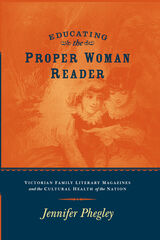 EDUCATING THE PROPER WOMAN READER: VICTORIAN FAMILY LITERARY MAGAZINES & CULTURAL HEALTH OF THE NATION
Jennifer Phegley
Ohio State University Press, 2004 Jennifer Phegley presents an examination of four mid-Victorian magazines that middle-class women read widely. Educating the Proper Woman Reader reevaluates prevailing assumptions about the vexed relationship between nineteenth-century women readers and literary critics. While many scholars have explored the ways nineteenth-century critics expressed their anxiety about the dangers of women’s unregulated and implicitly uncritical reading practices, which were believed to threaten the sanctity of the home and the cultural status of the nation, Phegley argues that family literary magazines revolutionized the position of women as consumers of print by characterizing them as educated readers and able critics. Her analysis of images of influential women readers (in Harper’s), intellectual women readers (in The Cornhill), independent women readers (in Belgravia), and proto-feminist women readers/critics (in Victoria) indicates that women played a significant role in determining the boundaries of literary culture within these magazines. She argues that these publications supported women’s reading choices, inviting them to define literary culture rather than to consume it passively. Not only does this book revise our understanding of nineteenth-century attitudes toward women readers, but it also takes a fresh look at the transatlantic context of literary production. Further, Phegley demonstrates the role these publications played in improving cultural literacy among women of the middle classes as well as the interplay between fiction and essays of the time by writers such as Mary Braddon, Charles Dickens, George Eliot, Elizabeth Gaskell, G. H. Lewes, Harriet Martineau, Margaret Oliphant, George Sala, William Thackeray, and Anthony Trollope.
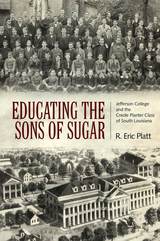 Educating the Sons of Sugar: Jefferson College and the Creole Planter Class of South Louisiana
R. Eric Platt
University of Alabama Press, 2017 A study of Louisiana French Creole sugar planters’ role in higher education and a detailed history of the only college ever constructed to serve the sugar elite
The education of individual planter classes—cotton, tobacco, sugar—is rarely treated in works of southern history. Of the existing literature, higher education is typically relegated to a footnote, providing only brief glimpses into a complex instructional regime responsive to wealthy planters. R. Eric Platt’s Educating the Sons of Sugar allows for a greater focus on the mindset of French Creole sugar planters and provides a comprehensive record and analysis of a private college supported by planter wealth.
Jefferson College was founded in St. James Parish in 1831, surrounded by slave-holding plantations and their cash crop, sugar cane. Creole planters (regionally known as the “ancienne population”) designed the college to impart a “genteel” liberal arts education through instruction, architecture, and geographic location. Jefferson College played host to social class rivalries (Creole, Anglo-American, and French immigrant), mirrored the revival of Catholicism in a region typified by secular mores, was subject to the “Americanization” of south Louisiana higher education, and reflected the ancienne population’s decline as Louisiana’s ruling population.
Resulting from loss of funds, the college closed in 1848. It opened and closed three more times under varying administrations (French immigrant, private sugar planter, and Catholic/Marist) before its final closure in 1927 due to educational competition, curricular intransigence, and the 1927 Mississippi River flood. In 1931, the campus was purchased by the Society of Jesus (Jesuits) and reopened as a silent religious retreat. It continues to function to this day as the Manresa House of Retreats. While in existence, Jefferson College was a social thermometer for the white French Creole sugar planter ethos that instilled the “sons of sugar” with a cultural heritage resonant of a region typified by the management of plantations, slavery, and the production of sugar.
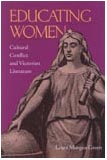 Educating Women: Cultural Conflict and Victorian Literature
Laura Morgan Green
Ohio University Press, 2001 In 1837, when Queen Victoria came to the throne, no institution of higher education in Britain was open to women. By the end of the century, a quiet revolution had occurred: women had penetrated even the venerable walls of Oxford and Cambridge and could earn degrees at the many new universities founded during Victoria's reign. During the same period, novelists increasingly put intellectually ambitious heroines students, teachers, and frustrated scholars—at the center of their books. Educating Women analyzes the conflict between the higher education movement's emphasis on intellectual and professional achievement and the Victorian novel's continuing dedication to a narrative in which women's success is measured by the achievement of emotional rather than intellectual goals and by the forging of social rather than institutional ties.
Focusing on works by Charlotte Brontë, George Eliot, Anna Leonowens, and Thomas Hardy, Laura Morgan Green demonstrates that those texts are shaped by the need to mediate the conflict between the professionalism and publicity increasingly associated with education, on the one hand, and the Victorian celebration of women as emblems of domesticity, on the other. Educating Women shows that the nineteenth-century “heroines” of both history and fiction were in fact as indebted to domestic ideology as they were eager to transform it.
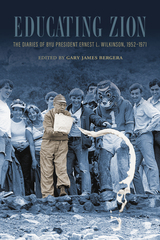 Educating Zion: The Diaries of Ernest L. Wilkinson, 1952–1971
Gary James Bergera
Signature Books, 2025 During the twenty years he served as president of LDS Church-owned Brigham Young University (1951–71), Ernest L. Wilkinson transformed the school into a showplace of the church’s educational values. "More than any other single cause," his successor, Dallin H. Oaks, observed, “[Wilkinson's] remarkable and relentless leadership . . . is the key to the present stature of Brigham Young University.” Under Wilkinson, the student body grew more than four-fold to 25,000, the faculty tripled, colleges and departments more than doubled, library holdings increased nearly 500 percent, the number of buildings jumped twenty-fold, and as perhaps the most telling manifestation of Wilkinson's influence, annual LDS Church subsidies rose fifteen-fold to $22 million. His single-minded drive to mold BYU into the kind of institution he hoped would command the admiration of American academia permanently set the direction for Latter-day Saint higher education. As he presided over this academic landscape, Wilkinson produced about 5,000 pages of typed, single-spaced diaries–—a literary creation that ranks among the most important diaries in the history of the Church of Jesus Christ of Latter-day Saints. Wilkinson also had access to the highest echelon of the church, writing of numerous meetings of the First Presidency and Quorum of the Twelve Apostles. Educating Zion assembles in one volume an annotated abridgement of those diary entries having the greatest interest to modern readers. The diaries are both a remarkable achievement and a phenomenal historical record whose importance cannot be overstated.
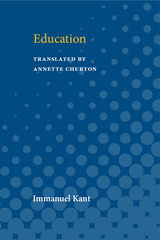 Education
Immanuel Kant
University of Michigan Press, 1960 Education presents Immanuel Kant’s profound reflections on the theory and practice of education. He argues that education is an essential process that distinguishes humans from animals, emphasizing that humans require nurturing, discipline, teaching, and culture to develop their innate potential. The book delves into physical education, intellectual cultivation, moral culture, and practical instruction, suggesting that education is not just about imparting knowledge or skill but also about shaping ethical and capable individuals. Kant underscores that true education involves both discipline and freedom, preparing individuals not only to conform to present societal norms but to strive for a higher moral and intellectual state. By combining philosophical insights with practical observations, Kant establishes that education should be a harmonized effort of both private and public sectors, aiming at the holistic development of human faculties toward the perfection of mankind.
Education Across a Century: The Centennial Volume
Edited by Lyn Corno
University of Chicago Press, 2001 NSSE's centennial volume emphasizes historically important educational themes in the context of the present and future; distinguished contributors look both at enduring, broad concerns (from curriculum and diversity to the psychology of learning) and specific trends in subject areas.
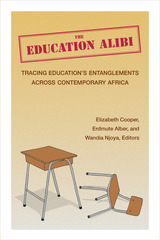 The Education Alibi: Tracing Education's Entanglements Across Contemporary Africa
Elizabeth Cooper, Erdmute Alber, and Wandia Njoya, Editors
University of Michigan Press, 2025 Education is generally promoted as the key to the future of Africa in global development discourses about the continent. Education’s official story in Africa continues to be one of innocence and public good, yet, since colonial times, education has constituted an area of intense contestation. The Education Alibi asks if it is possible that while claiming to be doing one thing, education has also been doing another in African communities. The concept of the “alibi” shines an interrogative light on institutions’ and actors’ use of education to divert scrutiny from other effects. Through ethnographic research and critical analysis across the continent, this volume focuses on people’s lived experiences to demonstrate how contemporary education systems in fact deepen economic, racialized, gendered, urban-rural, linguistic, religious, and other intranational and international inequalities.
Education and Democracy: The Meaning of Alexander Meiklejohn, 1872–1964
Adam R. Nelson
University of Wisconsin Press, 2001 This definitive biography of the charismatic Alexander Meiklejohn tracks his turbulent career as an educational innovator at Brown University, Amherst College, and Wisconsin’s “Experimental College” in the early twentieth century and his later work as a civil libertarian in the Joe McCarthy era. The central question Meiklejohn asked throughout his life’s work remains essential today: How can education teach citizens to be free?
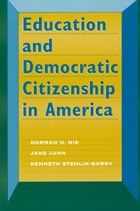 Education and Democratic Citizenship in America
Norman H. Nie, Jane Junn, and Kenneth Stehlik-Barry
University of Chicago Press, 1996 Formal education is crucial for creating enlightened and active citizens. The better educated are more engaged, more knowledgeable, and more politically tolerant. Despite a dramatic increase in education attainment over the last quarter century, political engagement has not risen at a commensurate level. How and why education affects citizenship in these ways has until now been a puzzle.
Norman H. Nie, Jane Junn, and Kenneth Stehlik-Barry provide answers by uncovering the causal relationship between education and democratic citizenship. They argue that citizenship encompasses both political engagement in pursuit of interests and commitment to democratic values that temper what citizens can do to win in politics. Education affects the two dimensions in distinct ways. Especially significant is the influence of education on political engagement through occupational prominence and position in social networks. Formal education orders the distribution of social position and connections and creates an uneven political playing field.
Education and Development in Korea
Noel F. McGinn, Donald R. Snodgrass, Yong Bong Kim, Shin Bok Kim, and Quee Yong Kim
Harvard University Press, 1980 This volume examines major theories of the relationships between education and political and economic development in the context of experiences of South Korea. Covering the years 1945-1975, the book includes analyses of changes in curriculum goals and practices, the impact of planning, costs and financing of education and political and economic outcomes. It reviews previous works in English and Korean and analyzes previously unavailable sociological and economic data.
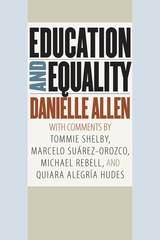 Education and Equality
Danielle Allen
University of Chicago Press, 2016 American education as we know it today—guaranteed by the state to serve every child in the country—is still less than a hundred years old. It’s no wonder we haven’t agreed yet as to exactly what role education should play in our society. In these Tanner Lectures, Danielle Allen brings us much closer, examining the ideological impasse between vocational and humanistic approaches that has plagued educational discourse, offering a compelling proposal to finally resolve the dispute.
Allen argues that education plays a crucial role in the cultivation of political and social equality and economic fairness, but that we have lost sight of exactly what that role is and should be. Drawing on thinkers such as John Rawls and Hannah Arendt, she sketches out a humanistic baseline that re-links education to equality, showing how doing so can help us reframe policy questions. From there, she turns to civic education, showing that we must reorient education’s trajectory toward readying students for lives as democratic citizens. Deepened by commentaries from leading thinkers Tommie Shelby, Marcelo Suárez-Orozco, Michael Rebell, and Quiara Alegría Hudes that touch on issues ranging from globalization to law to linguistic empowerment, this book offers a critical clarification of just how important education is to democratic life, as well as a stirring defense of the humanities.
Education and Foreign Aid: Ways to Improve United States Foreign Educational Aid; Problems and Prospects of Education in Africa
Philip H. Coombs
Harvard University Press In Ways to Improve United States Foreign Educational Aid, Philip H. Coombs analyzes the recent experience of governmental and private educational aid to developing countries, examines the lessons derived from that experience, and suggests methods for improvements.
In Problems and Prospects of Education in Africa, Karl W. Bigelow provides an up-to-date survey and interpretation of the educational scene in British-related Africa describing the major problems facing that area, and speculates on probable future developments.
Education and the Commercial Mindset
Samuel E. Abrams
Harvard University Press, 2016 America’s commitment to public schooling once seemed unshakable. But today the movement to privatize K–12 education is stronger than ever. Samuel E. Abrams examines the rise of market forces in public education and reveals how a commercial mindset has taken over.
“[An] outstanding book.”
—Carol Burris, Washington Post
“Given the near-complete absence of public information and debate about the stealth effort to privatize public schools, this is the right time for the appearance of [this book]. Samuel E. Abrams, a veteran teacher and administrator, has written an elegant analysis of the workings of market forces in education.”
—Diane Ravitch, New York Review of Books
“Education and the Commercial Mindset provides the most detailed and comprehensive analysis of the school privatization movement to date. Students of American education will learn a great deal from it.”
—Leo Casey, Dissent
 Education and the Creative Potential
E. Torrance
University of Minnesota Press, 1963
Education and the Creative Potential was first published in 1963. Minnesota Archive Editions uses digital technology to make long-unavailable books once again accessible, and are published unaltered from the original University of Minnesota Press editions.Modern School Practices Series, Number 5How can we identify creative children? What makes them different from other youngsters, and what happens to them in today’s schools? How can we improve our schools to make the most of our creative potential? Dr. Torrance, a leading educational psychologist, discussed such challenging questions and proposes challenges in the schools which will give children a better chance to learn and think creatively. He summarizes much of what is known about the conditions which nurture or inhibit creative growth and reports on a series of original, exploratory studies concerned with the problems of testing creative ability or potentiality and the influence of various factors on the development of creativity.This book is recommended by the National Council of Teachers of English as a standard reference for high school English classrooms and departments.
Education and the Cult of Efficiency
Raymond E. Callahan
University of Chicago Press, 1964 Raymond Callahan's lively study exposes the alarming lengths to which school administrators went, particularly in the period from 1910 to 1930, in sacrificing educational goals to the demands of business procedures. He suggests that even today the question still asked is: "How can we operate our schools?" Society has not yet learned to ask: "How can we provide an excellent education for our children?"
 Education and the Culture of Print in Modern America
Adam R. Nelson
University of Wisconsin Press, 2010 Vividly revealing the multiple layers on which print has been produced, consumed, regulated, and contested for the purpose of education since the mid-nineteenth century, the historical case studies in Education and the Culture of Print in Modern America deploy a view of education that extends far beyond the confines of traditional classrooms. The nine essays examine “how print educates” in settings as diverse as depression-era work camps, religious training, and broadcast television—all the while revealing the enduring tensions that exist among the controlling interests of print producers and consumers. This volume exposes what counts as education in American society and the many contexts in which education and print intersect.
Offering perspectives from print culture history, library and information studies, literary studies, labor history, gender history, the history of race and ethnicity, the history of science and technology, religious studies, and the history of childhood and adolescence, Education and the Culture of Print in Modern America pioneers an investigation into the intersection of education and print culture.
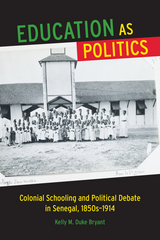 Education as Politics: Colonial Schooling and Political Debate in Senegal, 1850s–1914
Kelly M. Duke Bryant
University of Wisconsin Press, 2015 In 1914, Blaise Diagne was elected as Senegal’s first black African representative to the National Assembly in France. Education as Politics reinterprets the origins and significance of this momentous election, showing how colonial schools had helped reshape African power and politics during the preceding decades and how they prepared the way for Diagne’s victory.
Kelly M. Duke Bryant demonstrates the critical impact of colonial schooling on Senegalese politics by examining the response to it by Africans from a variety of backgrounds and statuses—including rural chiefs, Islamic teachers, and educated young urbanites. For those Africans who chose to engage with them, the French schools in Senegal provided a new source of patronage, a potentially beneficial connection to the bureaucratizing colonial state, a basis for claims to authority or power, or an arena in which to debate pressing issues like the future of Qur’anic schooling and the increasing racism of urban society under colonial rule.
Based on evidence from archives in Senegal and France, and on interviews Duke Bryant conducted in Senegal, she demonstrates that colonial schooling remade African politics during this period of transition to French rule, creating political spaces that were at once African and colonial, and ultimately allowing Diagne to claim election victory.
Education as World Building
Thomas Davidson
Harvard University Press Starting with the general statement that the aim of education must be to enable the human being to construct a world capable of yielding the highest and most varied satisfaction, Thomas Davidson in this stimulating essay develops three specific ideas: first, that the aim of all education, as of all life, is the evolution of the social individual in knowledge, sympathy, and will; second, that the evolution of the individual is the evolution of an ordered world in his consciousness; third, that ethical life depends upon the completeness and harmony of the world evolved in the individual consciousness. After demonstrating these three theses, he goes farther and shows how an inner world conditioning a moral life may be built up. The Introduction gives interesting biographical details regarding Davidson, whom the London Spectator once spoke of as one of the twelve most learned men on the planet.
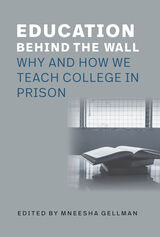 Education Behind the Wall: Why and How We Teach College in Prison
Edited by Mneesha Gellman
Brandeis University Press, 2022 An edited volume reflecting on different aspects of teaching in prison and different points of view. This book seeks to address some of the major issues faced by faculty who are teaching college classes for incarcerated students. Composed of a series of case studies meant to showcase the strengths and challenges of teaching a range of different disciplines in prison, this volume brings together scholars who articulate some of the best practices for teaching their expertise inside alongside honest reflections on the reality of educational implementation in a constrained environment. The book not only provides essential guidance for faculty interested in developing their own courses to teach in prisons, but also places the work of higher education in prisons in philosophical context with regards to racial, economic, social, and gender-based issues. Rather than solely a how-to handbook, this volume also helps readers think through the trade-offs that happen when teaching inside, and about how to ensure the full integrity of college access for incarcerated students.
 Education, Culture, and Identity in Twentieth-Century China
Glen Peterson, Ruth Hayhoe, and Yongling Lu, Editors
University of Michigan Press, 2001 Educational pursuits run like a rich thread through the fabric of China's turbulent twentieth century. From the founding of China's first modern school system in the late Qing dynasty through the republican era to the latest educational developments in the People's Republic of China, this book seeks to understand how developments in education contributed to, and were in turn influenced by, cultural patterns and the ongoing search for identity by individuals, collectivities, and states. Its sixteen contributors explore three themes that have enlivened China studies in recent years: sino-foreign interactions, state-society relations, and gender representation and identification.
Unlike most studies of modern Chinese education that focus exclusively on the post-1949 era, Education, Culture, and Identity in Twentieth-Century China represents a deliberate attempt to break through the 1949 barrier and embrace the entire century. Culture emerges in this study as a deeper level factor that underlay the development of education in each period and shaped certain recurrent patterns, while identity involves a search for individual and collective meaning that went on under different regimes.
The product of a genuinely multidisciplinary effort to promote cross-fertilization among an international team of scholars in a wide range of disciplines, Education, Culture, and Identity in Twentieth-Century China will interest students and scholars of modern China, comparative and international education, educational policy, and international relations. It will also appeal to policy makers and professionals associated with international organizations.
Glen Peterson is Associate Professor of History, University of British Columbia. Ruth Hayhoe is Director, Hong Kong Institute of Education. Yongling Lu is a graduate student in the History Department, Stanford University.
Education, Disadvantage and Place: Making the Local Matter
Kirstin Kerr, Alan Dyson, and Carlo Raffo
Bristol University Press, 2014 Cuts to education funding throughout the developed world are making it more important than ever that we understand the link between education, disadvantage, and place. This book is the first to focus in depth on area-based initiatives in the struggle for educational equality, bringing together a wide range of evidence on the effectiveness of past initiatives, identifying promising recent developments, and outlining innovative ways forward. Drawing on these findings, it offers guidance for local policy makers, educators, and social workers to help them actively respond to the complexities of place.
 Education for Democracy: Essays and Addresses
John Johnston
University of Minnesota Press, 1934 Education for Democracy was first published in 1934. Minnesota Archive Editions uses digital technology to make long-unavailable books once again accessible, and are published unaltered from the original University of Minnesota Press editions.“The Greek ideal of the citizen realizing himself in the state” is the heart of Dean Johnston’s philosophy developed in this book. He is concerned not merely with education, but with our current economic, political, social, and ethical problems, which education directed toward service to the state may help to solve.This is a book in which an ideal rather than a theory of education is clearly stated at the beginning, and developed like a theme in music. The author, speaking from a long and varied experience as scientist, teacher, and college administrator, sees the only hope of a future democratic state in the selection and training of competent and unselfish leaders.This selection, he firmly believes, is the task of the schools and especially of the colleges. By “selection” he means – he is careful to point out – not the exclusion of any capable person from higher education, but a careful fitting of every individual for the occupation in which he will be most happy and will render the best service to society.The papers collected here all deal with some variation of this theme. They draw up a striking indictment of many current educational practices, while pointing the way, as this prominent educator sees it, toward the alleviation of that “social manic-depressive insanity” with which our civilization is now afflicted.
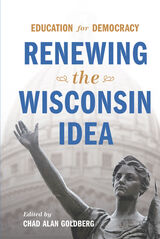 Education for Democracy: Renewing the Wisconsin Idea
Edited by Chad Alan Goldberg
University of Wisconsin Press, 2020 American public universities were founded in a civic tradition that differentiated them from their European predecessors—steering away from the pursuit of knowledge for its own sake. Like many such higher education institutions across the United States, the University of Wisconsin’s mission, known as the Wisconsin Idea, emphasizes a responsibility to serve the needs of the state and its people. This commitment, which necessarily requires a pledge to academic freedom, has recently been openly threatened by state and federal actors seeking to dismantle a democratic and expansive conception of public service.
Using the Wisconsin Idea as a lens, Education for Democracy argues that public higher education institutions remain a bastion of collaborative problem solving. Examinations of partnerships between the state university and people of the state highlight many crucial and lasting contributions to issues of broad public concern such as conservation, LGBTQ+ rights, and poverty alleviation. The contributors restore the value of state universities and humanities education as a public good, contending that they deserve renewed and robust support.
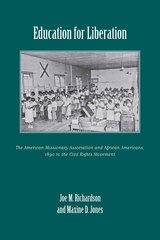 Education for Liberation: The American Missionary Association and African Americans, 1890 to the Civil Rights Movement
Joe M. Richardson
University of Alabama Press, 2009 Education for Liberation completes the study Dr. Richardson published in 1986 as Christian Reconstruction: The American Missionary Association and Southern Blacks, 1861-1890 by continuing the account of the American Missionary Association (AMA) from the end of Reconstruction to the post-World War II era.
Even after the optimism of Reconstruction was shattered by violence, fraud, and intimidation and the white South relegated African Americans to segregated and disfranchised second-class citizenship, the AMA never abandoned its claim that blacks were equal in God’s sight, that any “backwardness” was the result of circumstance rather than inherent inferiority, and that blacks could and should become equal citizens with other Americans. The organization went farther in recognition of black ability, humanity, and aspirations than much of 19th and 20th century white America by publicly and consistently opposing lynching, segregation, disfranchisement, and discrimination. The AMA regarded education as the means to full citizenship for African Americans and supported scores of elementary and secondary schools and several colleges at a time when private schooling offered almost the only chance for black youth to advance beyond the elementary grades. Such AMA schools, with their interracial faculties and advocacy for basic civil rights for black citizens, were a constant challenge to southern racial norms, and trained thousands of leaders in all areas of black life.
 Education for Nursing: A History of the University of Minnesota School
James Gray
University of Minnesota Press, 1960 Education for Nursing was first published in 1960. Minnesota Archive Editions uses digital technology to make long-unavailable books once again accessible, and are published unaltered from the original University of Minnesota Press editions.In the history of nursing in modern times, the University of Minnesota School of Nursing has played a distinguished and significant role as the first training center of its kind sponsored by an institution of higher learning. James Gray tells the story of this pioneering educational experiment in a perceptive and highly readable account.When the Minnesota School was established in 1909, nursing was just beginning to emerge from its status as humble handmaiden to the medical profession. A highly articulate group of leaders among nurses themselves in that period began to insist on the importance of giving the student a broad background in biological science and a full experience in clinical practice. At this same time, there happened to be a member of the faculty of the University of Minnesota medical school, Dr. Richard Olding Beard, who believed in the importance of well-prepared nurses in the campaign for better health. Along with the dean of the medical school, Dr. Elias P. Lyon, he worked steadily to create at Minnesota a system of instruction which would fit a carefully selected candidate to assume an ever increasing share of responsibility for patient care. A fortunate selection of directors has kept the Minnesota School of Nursing well in the forefront of study, experiment, and innovation in methods of instruction. The school has, from its start, assumed leadership for the improvement of nursing education and it looks forward to an equally important responsibility in providing the profession with workers in the research field.
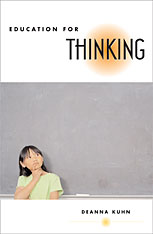 Education for Thinking
Deanna Kuhn
Harvard University Press, 2008 What do we want schools to accomplish? The only defensible answer, Deanna Kuhn argues, is that they should teach students to use their minds well, in school and beyond.
Bringing insights from research in developmental psychology to pedagogy, Kuhn maintains that inquiry and argument should be at the center of a “thinking curriculum”—a curriculum that makes sense to students as well as to teachers and develops the skills and values needed for lifelong learning. We have only a brief window of opportunity in children’s lives to gain (or lose) their trust that the things we ask them to do in school are worth doing. Activities centered on inquiry and argument—such as identifying features that affect the success of a music club catalog or discussing difficult issues like capital punishment—allow students to appreciate their power and utility as they engage in them.
Most of what students do in schools today simply does not have this quality. Inquiry and argument do. They are education for life, not simply more school, and they offer a unifying purpose for compulsory schooling as it serves an ever more diverse and challenging population.
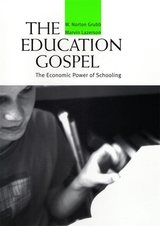 The Education Gospel: The Economic Power of Schooling
W. Norton Grubb and Marvin Lazerson
Harvard University Press, 2007 In this hard-hitting history of "the gospel of education," W. Norton Grubb and Marvin Lazerson reveal the allure, and the fallacy, of the longstanding American faith that more schooling for more people is the remedy for all our social and economic problems--and that the central purpose of education is workplace preparation.
But do increasing levels of education accurately represent the demands of today's jobs? Grubb and Lazerson argue that the abilities developed in schools and universities and the competencies required in work are often mismatched--since many Americans are under-educated for serious work while at least a third are over-educated for the jobs they hold. The ongoing race for personal advancement and the focus on worker preparation have squeezed out civic education and learning for its own sake. Paradoxically, the focus on schooling as a mechanism of equity has reinforced social inequality. The challenge now, the authors show, is to create environments for learning that incorporate both economic and civic goals, and to prevent the further descent of education into a preoccupation with narrow work skills and empty credentials.
Education in a New Society: Renewing the Sociology of Education
Edited by Jal Mehta and Scott Davies
University of Chicago Press, 2018 In recent decades, sociology of education has been dominated by quantitative analyses of race, class, and gender gaps in educational achievement. And while there’s no question that such work is important, it leaves a lot of other fruitful areas of inquiry unstudied. This book takes that problem seriously, considering the way the field has developed since the 1960s and arguing powerfully for its renewal.
The sociology of education, the contributors show, largely works with themes, concepts, and theories that were generated decades ago, even as both the actual world of education and the discipline of sociology have changed considerably. The moment has come, they argue, to break free of the past and begin asking new questions and developing new programs of empirical study. Both rallying cry and road map, Education in a New Society will galvanize the field.
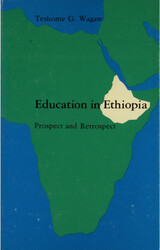 Education in Ethiopia: Prospect and Retrospect
Teshome G. Wagaw
University of Michigan Press, 2025 The Ancient Greeks imagined it to be the abode of the gods; scholars of the Middle Ages called it the land of Prester John; the prophent Mohammed urged the faithful to seek refuge from religious persecution among the hospitible people of Abyssinia. One of the oldest independent nations-states in the word, Ethiopia is little known or understood by the outside world even today. In this book, a native scholar and educator examines one area of Ethiopian history—educational change. Working from first-hand sources, personal experiences, and archival documents, Professor Wagaw analyzes the development of education in Ethiopia from an ancient, rigid, church-controlled system to the modern public school system, a product of changing times and public demand. This is an invaluable source for those interested in Ethiopian culture and education, those engaged in research in comparative education, and those interested in the process of African and Third World modernization.
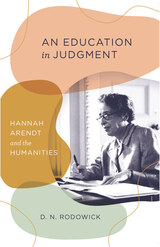 An Education in Judgment: Hannah Arendt and the Humanities
D. N. Rodowick
University of Chicago Press, 2021 Rodowick takes after the theories of Hannah Arendt and argues that thinking is an art we practice with and for each other in our communities.
In An Education in Judgment, philosopher D. N. Rodowick makes the definitive case for a philosophical humanistic education aimed at the cultivation of a life guided by both self-reflection and interpersonal exchange. Such a life is an education in judgment, the moral capacity to draw conclusions alone and with others, and letting one’s own judgments be answerable to the potentially contrasting judgments of others. Thinking, for Rodowick, is an art we practice with and learn from each other on a daily basis.
In taking this approach, Rodowick follows the lead of Hannah Arendt, who made judgment the cornerstone of her conception of community. What is important for Rodowick, as for Arendt, is the cultivation of “free relations,” in which we allow our judgments to be affected and transformed by those of others, creating “an ever-widening fabric of intersubjective moral consideration.” That is a fragile fabric, certainly, but one that Rodowick argues is worth pursuing, caring for, and preserving. This original work thinks with and beyond Arendt about the importance of the humanities and what “the humanities” amounts to beyond the walls of the university.
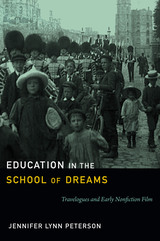 Education in the School of Dreams: Travelogues and Early Nonfiction Film
Jennifer Lynn Peterson
Duke University Press, 2013 In the earliest years of cinema, travelogues were a staple of variety film programs in commercial motion picture theaters. These short films, also known as "scenics," depicted tourist destinations and exotic landscapes otherwise inaccessible to most viewers. Scenics were so popular that they were briefly touted as the future of film. But despite their pervasiveness during the early twentieth century, travelogues have been overlooked by film historians and critics. In Education in the School of Dreams, Jennifer Lynn Peterson recovers this lost archive. Through innovative readings of travelogues and other nonfiction films exhibited in the United States between 1907 and 1915, she offers fresh insights into the aesthetic and commercial history of early cinema and provides a new perspective on the intersection of American culture, imperialism, and modernity in the nickelodeon era. Peterson describes the travelogue's characteristic form and style and demonstrates how imperialist ideologies were realized and reshaped through the moving image. She argues that although educational films were intended to legitimate filmgoing for middle-class audiences, travelogues were not simply vehicles for elite ideology. As a form of instructive entertainment, these technological moving landscapes were both formulaic and also wondrous and dreamlike. Considering issues of spectatorship and affect, Peterson argues that scenics produced and disrupted viewers' complacency about their own place in the world.
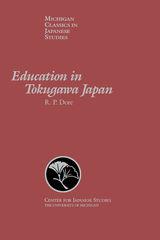 Education in Tokugawa Japan
R. P. Dore
University of Michigan Press, 1992 “This careful and important study of the development of the varied types of education in the last two and a half centuries of feudalism in Japan under the Tokugawa dictatorship (1600–1868) is more than a history of premodern education. It is also an intellectual history and a history of the educational philosophy of the writers of that period. Basing his work on extensive Japanese primary sources, the author has selected and organized his material well; thus his study fills an important gap in our knowledge of Japanese history.” —Hugh Borton, Haverford College, American Historical Review 71, no. 4 (July 1966): 1410–11. “There is no other book like it. . . . Readers already familiar with earlier books by Ronald Dore will rightly have guessed that we have been given yet another tour de force. Utilizing a remarkable amount of primary source material and discussing its implications with his customary grace and clarity, the author deals with the educational institutions for both samurai and commoner and the curricula of the bewildering variety of schools of Japan from the beginning of the 17th century through the Meiji Restoration in 1868. Yet this is in no sense a book of restricted interest, for it has as much to say to the student of sociocultural change as to the Japan specialist.” —R. J. Smith, Cornell University, American Anthropologist 68, no. 4 (August 1966), 1086–87.
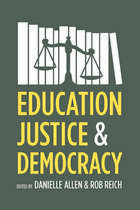 Education, Justice, and Democracy
Edited by Danielle Allen and Rob Reich
University of Chicago Press, 2013 Education is a contested topic, and not just politically. For years scholars have approached it from two different points of view: one empirical, focused on explanations for student and school success and failure, and the other philosophical, focused on education’s value and purpose within the larger society. Rarely have these separate approaches been brought into the same conversation. Education, Justice, and Democracy does just that, offering an intensive discussion by highly respected scholars across empirical and philosophical disciplines. The contributors explore how the institutions and practices of education can support democracy, by creating the conditions for equal citizenship and egalitarian empowerment, and how they can advance justice, by securing social mobility and cultivating the talents and interests of every individual. Then the authors evaluate constraints on achieving the goals of democracy and justice in the educational arena and identify strategies that we can employ to work through or around those constraints. More than a thorough compendium on a timely and contested topic, Education, Justice, and Democracy exhibits an entirely new, more deeply composed way of thinking about education as a whole and its importance to a good society.
 The Education Mayor: Improving America's Schools
Kenneth K. Wong, Francis X. Shen, Dorothea Anagnostopoulos, and Stacey Rutledge
Georgetown University Press, 2007 In 2002 the No Child Left Behind Act rocked America's schools with new initiatives for results-based accountability. But years before NCLB was signed, a new movement was already under way by mayors to take control of city schools from school boards and integrate the management of public education with the overall governing of the city. The Education Mayor is a critical look at mayoral control of urban school districts, beginning with Boston's schools in 1992 and examining more than 100 school districts in 40 states. The authors seek to answer four central questions:
• What does school governance look like under mayoral leadership?
• How does mayoral control affect school and student performance?
• What are the key factors for success or failure of integrated governance?
• How does mayoral control effect practical changes in schools and classrooms? The results of their examination indicate that, although mayoral control of schools may not be appropriate for every district, it can successfully emphasize accountability across the education system, providing more leverage for each school district to strengthen its educational infrastructure and improve student performance. Based on extensive quantitative data as well as case studies, this analytical study provides a balanced look at America's education reform. As the first multidistrict empirical examination and most comprehensive overall evaluation of mayoral school reform, The Education Mayor is a must-read for academics, policymakers, educational administrators, and civic and political leaders concerned about public education.
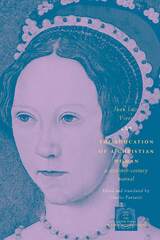 The Education of a Christian Woman: A Sixteenth-Century Manual
Juan Luis Vives
University of Chicago Press, 2000 "From meetings and conversation with men, love affairs arise. In the midst of pleasures, banquets, dances, laughter, and self-indulgence, Venus and her son Cupid reign supreme. . . . Poor young girl, if you emerge from these encounters a captive prey! How much better it would have been to remain at home or to have broken a leg of the body rather than of the mind!" So wrote the sixteenth-century Spanish humanist Juan Luis Vives in a famous work dedicated to Henry VIII's daughter, Princess Mary, but intended for a wider audience interested in the education of women.
Praised by Erasmus and Thomas More, Vives advocated education for all women, regardless of social class and ability. From childhood through adolescence to marriage and widowhood, this manual offers practical advice as well as philosophical meditation and was recognized soon after publication in 1524 as the most authoritative pronouncement on the universal education of women. Arguing that women were intellectually equal if not superior to men, Vives stressed intellectual companionship in marriage over procreation, and moved beyond the private sphere to show how women's progress was essential for the good of society and state.
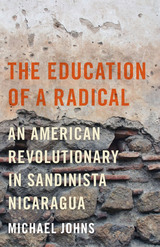 The Education of a Radical: An American Revolutionary in Sandinista Nicaragua
By Michael Johns
University of Texas Press, 2012 “I went to Nicaragua with nothing but a tourist visa, $1,500 in cash, the name of someone at the Agrarian Reform Ministry, and the idea of being a revolutionary intellectual. . . . The idea took hold in a simple character flaw: wanting to believe that I knew better than everyone else.” —From the preface When Michael Johns joined a Sandinista militia in 1983, a fellow revolutionary dubbed him a rábano, a radish: red on the outside but white on the inside. Now, more than twenty-five years later, Johns appreciates the wisdom of that label as he revisits the questions of identity he tried to resolve by working with the Sandinistas at that point in his life. In The Education of a Radical, Johns recounts his immersion in Marxism and the Nicaraguan sojourn it led to, with a painful maturation process along the way. His conversion began in college, where he joined a student group called the Latin American Solidarity Association and traveled to Chiapas, Mexico, for research on his senior thesis. Overwhelmed by the poverty he witnessed (and fascinated by a new friend named Maricela who was trying to turn peasants into revolutionaries and who carried a heavily highlighted copy of Late Capitalism), he experienced an ideological transformation. When a Marxist professor later encouraged him to travel to Nicaragua, the real internal battle began for him, a battle that was intensified by the U.S. invasion of Grenada and its effect on the Sandinistas, who believed they were the next target for an imminent American invasion. Before he knew it, Johns was digging trenches and learning how to use an AK-47. His intellectual ideals came face-to-face with revolutionary facts, and the results would perplex him for years to come. Bringing to life a vivid portrait of the sometimes painful process of reconciling reality with romanticized principles, The Education of a Radical encapsulates a trove of truths about humanity, economics, and politics in one man’s memorable journey.
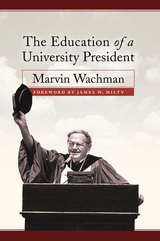 Education Of A University President
Marvin Wachman, foreword by James W. Hilty
Temple University Press, 2005 Marvin Wachman's parents were Russian Jewish immigrants with little formal education. Yet they instilled in their son the values of education, self-improvement, and perseverance. Because of Wachman's beliefs in human progress, he learned not only how to survive in hard times, but how to flourish. A newly minted PhD, Wachman served in World War II as a combat platoon sergeant where he was further drawn to teaching by his desire for work of lasting value. He proved a man of vision and administrative ability, qualities that suited him to lead two great universities renowned for their commitment to extending educational opportunity. During the Civil Rights era, Wachman served as the president of Lincoln University, the country's oldest historically Black college; later he guided Temple University to greater fiscal security, and under his leadership, education programs for Temple students were launched in Europe and Asia .The Education of a University President recalls Wachman's distinguished career in education and his steadfast dedication to liberal values.
The Education of a WASP
Lois M. Stalvey
University of Wisconsin Press, 1989 Brimming with honestly and passion, The Education of a WASP chronicles one white woman's discovery of racism in 1960s America. First published in 1970 and highly acclaimed by reviewers, Lois Stalvey's account is as timely now as it was then. Nearly twenty years later, with ugly racial incidents occurring on college campuses, in neighborhoods, and in workplaces everywhere, her account of personal encounters with racism remains deeply disturbing. Educators and general readers interested in the subtleties of racism will find the story poignant, revealing, and profoundly moving.
“Delightful and horrible, a singular book.” —Choice
“An extraordinarily honest and revealing book that poses the issue: loyalty to one’s ethnic group or loyalty to conscience.” —Publishers Weekly
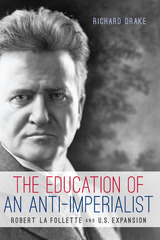 The Education of an Anti-Imperialist: Robert La Follette and U.S. Expansion
Richard Drake
University of Wisconsin Press, 2013 Robert M. La Follette (1855–1925), the Republican senator from Wisconsin, is best known as a key architect of American Progressivism and as a fiery advocate for liberal politics in the domestic sphere. But "Fighting Bob" did not immediately come to a progressive stance on foreign affairs. In The Education of an Anti-Imperialist, Richard Drake follows La Follette's growth as a critic of America's wars and the policies that led to them. He began his political career with conventional Republican views of the era on foreign policy, avidly supporting the Spanish-American and Philippine-American Wars. La Follette's critique of empire emerged in 1910, during the first year of the Mexican Revolution, as he began to perceive a Washington–Wall Street alliance in the United States' dealings with Mexico. La Follette subsequently became Congress's foremost critic of Woodrow Wilson, fiercely opposing United States involvement in World War I. Denounced in the American press as the most dangerous man in the country, he became hated and vilified by many but beloved and admired by others. La Follette believed that financial imperialism and its necessary instrument, militarism, caused modern wars. He contended they were twin evils that would have ruinous consequences for the United States and its citizens in the twentieth century and beyond.
“An excellent book. . . . As Drake fully documents, La Follette's warnings about [World War I] profiteers and the lust for power were fully justified. Then as now, the American people were lied to by the government and media and manipulated into the stink and blood of war."—Mark Taylor, The Daily Call
“Scholars will . . . value the insights into La Follette's foreign policy education.”—The Historian
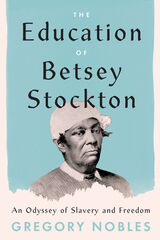 The Education of Betsey Stockton: An Odyssey of Slavery and Freedom
Gregory Nobles
University of Chicago Press, 2022 A perceptive and inspiring biography of an extraordinary woman born into slavery who, through grit and determination, became a historic social and educational leader.
The life of Betsey Stockton (ca. 1798–1865) is a remarkable story of a Black woman’s journey from slavery to emancipation, from antebellum New Jersey to the Hawai‘ian Islands, and from her own self-education to a lifetime of teaching others—all told against the backdrop of the early United States’ pervasive racism. It’s a compelling chronicle of a critical time in American history and a testament to the courage and commitment of a woman whose persistence grew into a potent form of resistance.
When Betsey Stockton was a child, she was “given, as a slave” to the household of Rev. Ashbel Green, a prominent pastor and later the president of what is now Princeton University. Although she never went to school, she devoured the books in Green’s library. After being emancipated, she used that education to benefit other people of color, first in Hawai‘i as a missionary, then Philadelphia, and, for the last three decades of her life, Princeton—a college town with a genteel veneer that never fully hid its racial hostility. Betsey Stockton became a revered figure in Princeton’s sizeable Black population, a founder of religious and educational institutions, and a leader engaged in the day-to-day business of building communities.
In this first book-length telling of Betsey Stockton’s story, Gregory Nobles illuminates both a woman and her world, following her around the globe, and showing how a determined individual could challenge her society’s racial obstacles from the ground up. It’s at once a revealing lesson on the struggles of Stockton’s times and a fresh inspiration for our own.
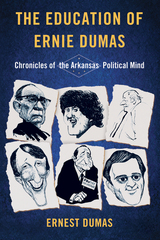 The Education of Ernie Dumas: Chronicles of the Arkansas Political Mind
Ernest Dumas
Butler Center for Arkansas Studies, 2019 Like The Education of Henry Adams, the early twentieth-century classic from which this book derives its name, Adams described the ascent, or descent, of a postwar social and political order into something that a few people called modernity. But Dumas follows this evolution, not in the United States as Adams did, but in insular Arkansas.
Beginning with the defeat of Governor Francis Cherry by the son of a hillbilly socialist at the end of the Joe McCarthy era, Dumas traces the development of a modernist political cast that eventually produced Arkansas’s first president of the United States. It follows the seed from 1978 that would germinate into the second impeachment of an American president.
Dumas has written for newspapers and about politics for sixty-three years, since 1954, the year that the stolid Cherry fell to Orval Eugene Faubus. The book is a political memoir that describes not only his education in the ways of politicians but the politicians’ own education and miseducation in how you win voters and then how you get things done.
It is mostly a collection of untold stories, often deeply personal, that reveal the inner struggles and sometimes the tribulations of the state’s leaders—Cherry, Faubus, Winthrop Rockefeller, Dale Bumpers, David Pryor, John McClellan, J. William Fulbright, Bill Clinton, Jim Guy Tucker, and others.
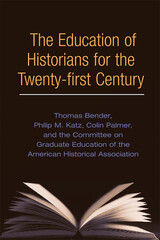 The Education of Historians for Twenty-first Century
Thomas Bender, Philip M. Katz, Colin Palmer, and the Committee on Graduate Education (AHA)
University of Illinois Press, 2004 An examination and analysis of history education in American colleges and universities In 1958, the American Historical Association began a study to determine the status and condition of history education in U.S. colleges and universities. Published in 1962 and addressing such issues as the supply and demand for teachers, student recruitment, and training for advanced degrees, that report set a lasting benchmark against which to judge the study of history thereafter. Now, more than forty years later, the AHA has commissioned a new report. The Education of Historians for the Twenty-first Century documents this important new study's remarkable conclusions. Both the American academy and the study of history have been dramatically transformed since the original study, but doctoral programs in history have barely changed. This report from the AHA explains why and offers concrete, practical recommendations for improving the state of graduate education. The Education of Historians for the Twenty-first Century stands as the first investigation of graduate training for historians in more than four decades and the best available study of doctoral education in any major academic discipline. Prepared for the AHA by the Committee on Graduate Education, the report represents the combined efforts of a cross-section of the entire historical profession. It draws upon a detailed review of the existing studies and data on graduate education and builds upon this foundation with an exhaustive survey of history doctoral programs. This included actual visits to history departments across the country and consultations with scores of individual historians, graduate students, deans, academic and non-academic employers of historians, as well as other stakeholders in graduate education. As the ethnic and gender composition of both graduate students and faculty has changed, methodologies have been refined and the domains of historical inquiry expanded. By addressing these revolutionary intellectual and demographic changes in the historical profession, The Education of Historians for the Twenty-first Century breaks important new ground. Combining a detailed historical snapshot of the profession with a rigorous analysis of these intellectual changes, this volume is ideally positioned as the definitive guide to strategic planning for history departments. It includes practical recommendations for handling institutional challenges as well as advice for everyone involved in the advanced training of historians, from department chairs to their students, and from university administrators to the AHA itself. Although focused on history, there are lessons here for any department. The Education of Historians for the Twenty-first Century is a model for in-depth analysis of doctoral education, with recommendations and analyses that have implications for the entire academy. This volume is required reading for historians, graduate students, university administrators, or anyone interested in the future of higher education.
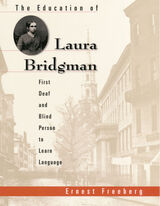 The Education of Laura Bridgman: First Deaf and Blind Person to Learn Language
Ernest Freeberg
Harvard University Press, 2002 In the mid-nineteenth century, Laura Bridgman, a young child from New Hampshire, became one of the most famous women in the world. Philosophers, theologians, and educators hailed her as a miracle, and a vast public followed the intimate details of her life with rapt attention. This girl, all but forgotten today, was the first deaf and blind person ever to learn language.
Laura’s dark and silent life was transformed when she became the star pupil of the educational crusader Dr. Samuel Gridley Howe. Against the backdrop of an antebellum Boston seething with debates about human nature, programs of moral and educational reform, and battles between conservative and liberal Christians, Ernest Freeberg tells this extraordinary tale of mentor and student, scientist and experiment.
Under Howe’s constant tutelage, Laura voraciously absorbed the world around her, learning to communicate through finger language, as well as to write with confidence. Her remarkable breakthroughs vindicated Howe’s faith in the power of education to overcome the most terrible of disabilities. In Howe’s hands, Laura’s education became an experiment that he hoped would prove his own controversial ideas about the body, mind, and soul.
Poignant and hopeful, The Education of Laura Bridgman is both a success story of how a sightless and soundless girl gained contact with an ever-widening world, and also a cautionary tale about the way moral crusades and scientific progress can compromise each other. Anticipating the life of Helen Keller a half-century later, Laura’s is a pioneering story of the journey from isolation to accomplishment, as well as a window onto what it means to be human under the most trying conditions.
The Education of Mrs. Henry Adams
Eugenia Kaledin
University of Massachusetts Press, 1994 Marian Hooper Adams--Clover, as her friends called her--was an accomplished photographer and a witty, irreverent free spirit who moved easily within the cultural circles of nineteenth-century Boston. Why, then, in 1882, at the age of forty-two, did she swallow a lethal dose of potassium cyanide? And why did her husband of thirteen years fail even to mention her in his autobiography, The Education of Henry Adams?
These and other questions are explored in this first paperback edition of Eugenia Kaledin's pathbreaking biography. The book re-creates the intense intellectual, cultural, and moral life of Boston and New England before, during, and after the Civil War and helps us to understand what could drive such a gifted, intelligent, and privileged woman to take her own life. Included is a portfolio of Adams's photographs of her husband and his famous circle.
The Education of Nations: A Comparison in Historical Perspective, Revised Edition
Robert Ulich
Harvard University Press In this far-ranging, incisive study, Robert Ulich analyzes the various forces that have molded the educational systems and common intellectual heritage of Western nations. Ulich has added to this revised edition of his work an important chapter describing new developments in educational policy.
 The Education of Phillips Brooks
John F. Woolverton
University of Illinois Press, 1995 Brooks's theological and intellectual lineage
The Education of Phillips Brooks probes the formative years of one of the best-known figures of Victorian America's "Gilded Age". Rigorously researched, bringing as yet untapped archival material into play, John F. Woolverton's book is an extremely readable and fascinating look at a gifted, persuasive clergyman and public figure. The sermon Brooks delivered at his Holy Trinity Church in Philadelphia while Abraham Lincoln's body lay in state overnight in Independence Hall was published, making him nationally famous overnight. He also is known for penning the lyrics to "O Little Town of Bethlehem". Although Brooks was not a major theologian, he was nurtured in an atmosphere of serious religious thought. In the crisis era of pre-Civil War America, he sought a religious and cultural ideal in the "perfect manhood" of Jesus Christ and consequently "won a name" for himself, as his slightly envious cousin, Henry Adams, once remarked. Woolverton places Brooks in his cultural context and shows how this religious leader was shaped psychologically and by his times and how those factors helped him forge a spiritual ideal for a troubled nation.
Education of Syrian Refugee Children: Managing the Crisis in Turkey, Lebanon, and Jordan
Shelly Culbertson
RAND Corporation, 2015 With four million Syrian refugees as of September 2015, there is urgent need to develop both short-term and long-term approaches to providing education for the children of this population. This report reviews Syrian refugee education for children in the three neighboring countries with the largest population of refugees—Turkey, Lebanon, and Jordan—and analyzes four areas: access, management, society, and quality.
The Education of Teachers
Edited by Gary A. Griffin
University of Chicago Press, 1999 This volume addresses persistent issues in the preservice and continuing education of teachers. Attention is focused upon perspectives on teacher education that differ significantly from those that have characterized views of this field in the past. Among developments that provide the current context for teacher education are the movement for standards, the emphasis upon inquiry in the classroom, increased expectations for teachers' participation in curriculum development, constructivism and the cognitive revolution, and professional development schools. These and other matters receive the attention of a distinguished group of scholars and practitioners in the field.
The Education of the Eye: History of the Royal Polytechnic Institution 1838-1881
Brenda Weeden
University of Westminster Press, 2008 The Royal Polytechnic Institution's story is the first episode in the long, diverse history of the University of Westminster. Drawing on an extensive range of primary and secondary sources this book explores the Institution's reputation for visual spectacle and the popularisation of science. It is lavishly illustrated with contemporary images.
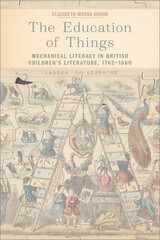 The Education of Things: Mechanical Literacy in British Children's Literature, 1762–1860
Elizabeth Massa Hoiem
University of Massachusetts Press, 2023 Finalist for the 2025 SHARP Book History Book Prize
Winner of the 2025 Justin G. Schiller Prize for Bibliographical Work on Children’s Books from The Bibliographical Society of America
By the close of the eighteenth century, learning to read and write became closely associated with learning about the material world, and a vast array of games and books from the era taught children how to comprehend the physical world of “things.” Examining a diverse archive of popular science books, primers, grammars, toys, manufacturing books, automata, and literature from Maria Edgeworth, Jean-Jacques Rousseau, and Anna Letitia Barbauld, The Education of Things attests that material culture has long been central to children’s literature. Elizabeth Massa Hoiem argues that the combination of reading and writing with manual tinkering and scientific observation promoted in late eighteenth- and early nineteenth-century Britain produced new forms of “mechanical literacy,” competencies that were essential in an industrial era. As work was repositioned as play, wealthy children were encouraged to do tasks in the classroom that poor children performed for wages, while working-class children honed skills that would be crucial to their social advancement as adults.
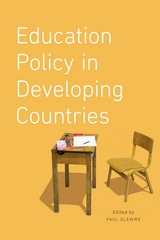 Education Policy in Developing Countries
Edited by Paul Glewwe
University of Chicago Press, 2013 Almost any economist will agree that education plays a key role in determining a country’s economic growth and standard of living, but what we know about education policy in developing countries is remarkably incomplete and scattered over decades and across publications. Education Policy in Developing Countries rights this wrong, taking stock of twenty years of research to assess what we actually know—and what we still need to learn—about effective education policy in the places that need it the most.
Surveying many aspects of education—from administrative structures to the availability of health care to parent and student incentives—the contributors synthesize an impressive diversity of data, paying special attention to the gross imbalances in educational achievement that still exist between developed and developing countries. They draw out clear implications for governmental policy at a variety of levels, conscious of economic realities such as budget constraints, and point to crucial areas where future research is needed. Offering a wealth of insights into one of the best investments a nation can make, Education Policy in Developing Countries is an essential contribution to this most urgent field.
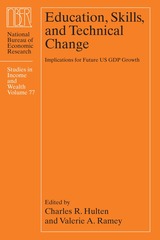 Education, Skills, and Technical Change: Implications for Future US GDP Growth
Edited by Charles R. Hulten and Valerie A. Ramey
University of Chicago Press, 2018 Over the past few decades, US business and industry have been transformed by the advances and redundancies produced by the knowledge economy. The workplace has changed, and much of the work differs from that performed by previous generations. Can human capital accumulation in the United States keep pace with the evolving demands placed on it, and how can the workforce of tomorrow acquire the skills and competencies that are most in demand?
Education, Skills, and Technical Change explores various facets of these questions and provides an overview of educational attainment in the United States and the channels through which labor force skills and education affect GDP growth. Contributors to this volume focus on a range of educational and training institutions and bring new data to bear on how we understand the role of college and vocational education and the size and nature of the skills gap. This work links a range of research areas—such as growth accounting, skill development, higher education, and immigration—and also examines how well students are being prepared for the current and future world of work.
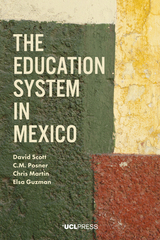 Education System in Mexico
David Scott, C.M. Posner, Chris Martin, and Elsa Guzman
University College London, 2018 Over the past three decades, a significant amount of research has sought to relate educational institutions, policies, practices, and reforms to social structures and agencies. A number of models have been developed that have become the basis for attempting to understand the complex relation between education and society. At the same time, national and international bodies tasked with improving educational performances seem to be writing in a void, in that there is no rigorous theory guiding their work, and their documents exhibit few references to groups, institutions and forces that can impede or promote their programs and projects. As a result, the recommendations these bodies provide to their clients display little to no comprehension of how and under what conditions the recommendations can be put into effect. The Education System in Mexico directly addresses this problem. By combining abstract insights with the practicalities of educational reforms, policies, practices, and their social antecedents, it offers a long overdue reflection of the history, effects and significance of the Mexican educational system, as well as presenting a more cogent understanding of the relationship between educational institutions and social forces in Mexico and around the world.
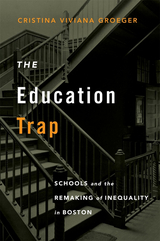 The Education Trap: Schools and the Remaking of Inequality in Boston
Cristina Viviana Groeger
Harvard University Press, 2021 Why—contrary to much expert and popular opinion—more education may not be the answer to skyrocketing inequality.
For generations, Americans have looked to education as the solution to economic disadvantage. Yet, although more people are earning degrees, the gap between rich and poor is widening. Cristina Groeger delves into the history of this seeming contradiction, explaining how education came to be seen as a panacea even as it paved the way for deepening inequality.
The Education Trap returns to the first decades of the twentieth century, when Americans were grappling with the unprecedented inequities of the Gilded Age. Groeger’s test case is the city of Boston, which spent heavily on public schools. She examines how workplaces came to depend on an army of white-collar staff, largely women and second-generation immigrants, trained in secondary schools. But Groeger finds that the shift to more educated labor had negative consequences—both intended and unintended—for many workers. Employers supported training in schools in order to undermine the influence of craft unions, and so shift workplace power toward management. And advanced educational credentials became a means of controlling access to high-paying professional and business jobs, concentrating power and wealth. Formal education thus became a central force in maintaining inequality.
The idea that more education should be the primary means of reducing inequality may be appealing to politicians and voters, but Groeger warns that it may be a dangerous policy trap. If we want a more equitable society, we should not just prescribe more time in the classroom, but fight for justice in the workplace.
Educational and Developmental Aspects of Deafness
Donald F. Moores
Gallaudet University Press, 1990 Educational and Developmental Aspects of Deafness details the ongoing revolution in the education of deaf children. More than 20 researchers contributed their discoveries in anthropology, education, linguistics, psychology, sociology, and other major disciplines, with special concentration upon the education of deaf children.
Divided into two parts on education at home and in school, this incisive book documents breakthroughs such as the public's interest in sign language, the increasing availability of interpreters, the growing perception of deafness as a social condition, not a pathology, and other positive trends. It is unique as the first purely research-based text and reference point for further study of the education of deaf children.
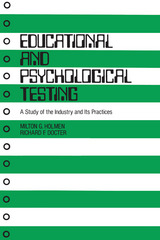 Educational and Psychological Testing: A Study of the Industry and its Practices
Martin Holeman
Russell Sage Foundation, 1972 Educational and psychological tests are often used in ways which touch most intimately the lives of people. For example, tests may influence who gets a job or who is selected to attend a college or graduate school. But not everyone has agreed that tests are a good thing. Over the past twenty years a wave of complaints has led to congressional hearings, court cases, and formal grievances before state and federal commissions. Holmen and Docter have analyzed these complaints and criticisms not only by considering the tests themselves but through examining the ways tests are used as elements in assessment systems. The applications of tests in clinical and counseling work, in educational achievement testing, and in personnel selection is discussed and evaluated. While the least amount of testing is in the personnel selections area, this is where the most complaints are found. Educational achievement testing has by far the largest testing programs and a wide range of criticisms has been voiced concerning this kind of assessment. Testing in connection with clinical and counseling work has generated the least public concern. An extensive analysis is given of the organizations which comprise the testing industry, including the various developers and publishers of tests and also test scoring organizations. The users of tests are considered from the standpoint of their professional training and also in terms of how their organizations influence technical standards of test development.
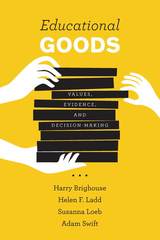 Educational Goods: Values, Evidence, and Decision-Making
Harry Brighouse, Helen F. Ladd, Susanna Loeb, and Adam Swift
University of Chicago Press, 2018 We spend a lot of time arguing about how schools might be improved. But we rarely take a step back to ask what we as a society should be looking for from education—what exactly should those who make decisions be trying to achieve?
In Educational Goods, two philosophers and two social scientists address this very question. They begin by broadening the language for talking about educational policy: “educational goods” are the knowledge, skills, and attitudes that children develop for their own benefit and that of others; “childhood goods” are the valuable experiences and freedoms that make childhood a distinct phase of life. Balancing those, and understanding that not all of them can be measured through traditional methods, is a key first step. From there, they show how to think clearly about how those goods are distributed and propose a method for combining values and evidence to reach decisions. They conclude by showing the method in action, offering detailed accounts of how it might be applied in school finance, accountability, and choice. The result is a reimagining of our decision making about schools, one that will sharpen our thinking on familiar debates and push us toward better outcomes.
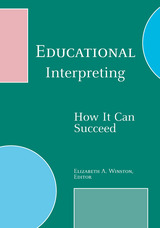 Educational Interpreting: How It Can Succeed
Elizabeth A. Winston
Gallaudet University Press, 2004 This incisive book explores the current state of educational interpreting and how it is failing deaf students. The contributors, all renowned experts in their field, include former educational interpreters, teachers of deaf students, interpreter trainers, and deaf recipients of interpreted educations.
Educational Interpreting presents the salient issues in three distinct sections. Part 1 focuses on deaf students—their perspectives on having interpreters in the classroom, the language myths that surround them, the accessibility of language to them, and their cognition. Part 2 raises questions about the support and training that interpreters receive from the school systems, the qualifications that many interpreters bring to an interpreted education, and the accessibility of everyday classrooms for deaf students placed in such environments. Part 3 presents a few of the possible suggestions for addressing the concerns of interpreted educations, and focuses primarily on the interpreter.
The contributors discuss the need to (1) define the core knowledge and skills interpreters must have and (2) develop standards of practice and assessment. They also stress that interpreters cannot effect the necessary changes alone; unless and until administrators, parents, teachers, and students recognize the inherent issues of access to education through mediation, little will change for deaf students.
The Educational Leadership Challenge: Redefining Leadership for the 21st Century
Edited by Joseph Murphy
University of Chicago Press, 2002 Part I of the National Society for the Study of Education's 101st yearbook explores the changing context of educational leadership in the twenty-first century through the lenses of school improvement, social justice, and democratic community. Authors discuss topics such as leadership roles for teachers, principals, and superintendents; rethinking professional development for school leaders; school improvement processes for building instructional capacity; and the evolving role of leadership in education over time.
Educational Mobility of Second-generation Turks: Cross-national Perspectives
Philip Schnell
Amsterdam University Press, 2014 This volume investigates educational inequalities among children of Turkish immigrants in Austria, France, and Sweden. One of the largest immigrant groups in these countries, Turks nonetheless face discrimination and limited opportunities, and this study shows how those problems play out in education. One of its key findings is that systems that provide more favorable institutional arrangements lead to greater economic mobility in the second generation.
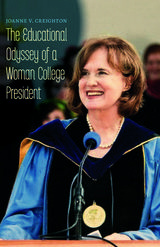 The Educational Odyssey of a Woman College President
Joanne V. Creighton
University of Massachusetts Press, 2018 Early in her tenure as president of Mount Holyoke College, Joanne V. Creighton faced crises as students staged protests and occupied academic buildings; the alumnae association threatened a revolt; and a distinguished professor became the subject of a major scandal. Yet Creighton weathered each storm, serving for nearly fifteen years in office and shepherding the college through a notable revitalization.
In her autobiography, The Educational Odyssey of a Woman College President, Creighton situates her tenure at Mount Holyoke within a life and career that have traversed breathtaking changes in higher education and social life. Having held multiple roles in academia spanning undergraduate, professor, and president, Creighton served at small colleges and large public universities and experienced the dramatic changes facing women across the academy. From her girlhood in Wisconsin to the presidency of a storied women's college, she bears witness to the forces that have reshaped higher education for women and continues to advocate for the liberal arts and sciences.
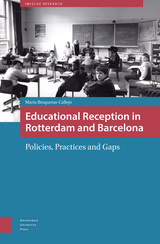 Educational Reception in Rotterdam and Barcelona: Policies, Practices and Gaps
Maria Bruquetas-Callejo
Amsterdam University Press, 2014 The reception of newcomer youngsters by schools constitutes a policy issue in Europe already for decades. This book deals with how practitioners in Rotterdam and Barcelona apply existing policies for the reception of immigrant students, the dilemmas they face and the strategies they design as a response. Using a combination of discursive, organizational, and ethnographic research techniques, the author studies to what extent practices conform to policies, and to what extent they diverge from them in basic principles. This book analyzes the influence of institutional frameworks on the practices of policy implementers by comparing Netherlands and Spain -specifically Barcelona and Rotterdam-, two cases which are very different in terms of their national policies of integration, their educational systems and their programs for educational reception. Much can be learned over the reception practices of secondary schools, but above all over how policy gaps work, and the common and specific features that they present across different countries. In short, this is an indispensable reading for scholars, policymakers and practitioners alike, which offers new insights about the policy-practice gap and the role of policy practitioners in it. Download the Table of Contents and a sample chapter
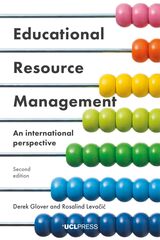 Educational Resource Management: An International Perspective
Edited by Derek Glover and Rosalind Levacic
University College London, 2020 Resource management, though a central responsibility of school and college leaders, is one that they are often unprepared for. Concise and contextual information and guidance are vital, especially as leaders are pressured from all sides to manage their resources astutely. This new edition of Educational Resource Management: An International Perspective is an updated and globally conscious guide to all aspects of this key responsibility.
Opening with a detailed overview of funding and resource management in public and private institutions, the book looks at the criteria by which the effectiveness, efficiency, and equity of educational resource management can be judged. It goes on to explore cost structures, budgets, and the principles of asset management through case studies that draw on practitioner experiences as well as the authors’ own observations. Educational Resource Management concludes with a review of current tensions and points towards further study, providing a succinct yet comprehensive guide for school and college leaders.
The Educational Work of Thomas Jefferson
Roy J. Honeywell
Harvard University Press This is a study not only of Jefferson’s plans for a system of elementary, secondary, and higher education in Virginia but of his educational philosophy and ideals. It represents an attempt to interpret passing references in private correspondence as well as formal discussions of educational subjects. The author also shows how Jefferson’s ideas and efforts have influenced American education. Jefferson’s own words are used freely, the quotations in many instances revealing quaint eccentricities of style. An extensive appendix reproduces the documents which set forth most fully the views and plans of this truly great educational pioneer.
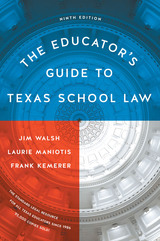 The Educator's Guide to Texas School Law: Ninth Edition
By Jim Walsh, Laurie Maniotis, and Frank Kemerer
University of Texas Press, 2018 Much has changed in the area of school law since the first edition of The Educator’s Guide was published in 1986. This new ninth edition offers an authoritative source on all major dimensions of Texas school law through the 2017 legislative sessions. Intended for educators, school board members, interested attorneys, and taxpayers, the ninth edition explains what the law is and what the implications are for effective school operations. It is designed to help professional educators avoid expensive and time-consuming lawsuits by taking effective preventive action. It is an especially valuable resource for school law courses and staff development sessions.
The ninth edition begins with a review of the legal structure of the Texas school system, incorporating recent innovative features such as charter schools and districts of innovation. Successive chapters address attendance, the instructional program, service to students with special needs, the rights of public school employees, the role of religion, student discipline, governmental transparency, privacy, parent rights, and the parameters of legal liability for schools and school personnel. The book includes discussion of major federal legislation, such as the Individuals with Disabilities Education Act, the Family Educational Rights and Privacy Act, Section 504 of the Rehabilitation Act of 1973, and the Every Student Succeeds Act. On the state level, the book incorporates new laws pertaining to cyberbullying and inappropriate relationships between students and employees. Key points are illustrated through case law, and a complete index of case citations is included.
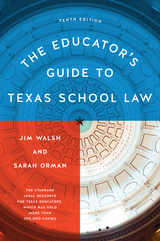 The Educator's Guide to Texas School Law: Tenth Edition
Jim Walsh and Sarah Orman
University of Texas Press, 2022 Much has changed in the area of school law since the first edition of The Educator’s Guide to Texas School Law was published in 1986. This new tenth edition of The Educator’s Guide offers an authoritative source on Texas school law through the 2021 legislative sessions. Intended for educators, school board members, attorneys, and taxpayers, it explains what the law is and what the implications are for effective school operations; it helps professional educators avoid expensive and time-consuming lawsuits by taking effective preventive action; and it serves as a highly valuable resource for school law courses and staff development sessions. The tenth edition begins with a review of the legal structure of the Texas school system, incorporating recent features such as charter schools and districts of innovation, then addresses the instructional program, service to students with special needs, the rights of public school employees, the role of religion, student discipline, governmental transparency, privacy, parental rights, and the parameters of legal liability for schools and school personnel. The book includes discussion of major federal legislation, such as the Individuals with Disabilities Education Act, the Family Educational Rights and Privacy Act, Section 504 of the Rehabilitation Act of 1973, and Title IX. On the state level, the book incorporates laws pertaining to cyberbullying, inappropriate relationships between students and employees, and human sexuality instruction.
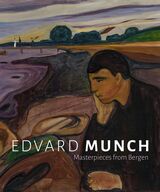 Edvard Munch: Masterpieces from Bergen
Edited by Barnaby Wright
Paul Holberton Publishing, 2022 A showcase of eighteen masterworks by one of the world’s greatest modern artists.
This important publication accompanies a major exhibition at the Courtauld Gallery, London, of paintings by Edvard Munch (1863–1944). The catalog and accompanying exhibition showcase eighteen major works from the collection of KODE Art Museums in Bergen, one of the most important collections of Munch paintings in the world. The works span the most significant part of Munch’s artistic development and have never before been shown as a group outside of Scandinavia.
This book explores this group of remarkable works in detail and considers the important role of its collector, Rasmus Meyer. The exhibition and publication include seminal paintings from Munch’s early “realist” phase of the 1880s, such as Morning and Summer Night, pivotal works that show the artist’s move towards the expressive and psychologically charged work for which he became famous. These paintings launched Munch’s career and set the stage for his renowned, highly expressive paintings of the 1890s. Such works are a major feature of the exhibition that includes remarkable canvases from Munch’s famous Frieze of Life series, which address profound themes of human existence, from love to death. Munch’s powerful use of color and form marked him as one of the most radical painters at the turn of the twentieth century.
This fully illustrated publication includes a catalog of the works, with contributions by leading experts in their field from KODE and the Courtauld.
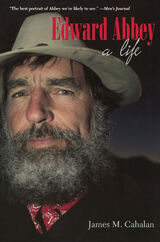 Edward Abbey: A Life
James M. Cahalan
University of Arizona Press, 2001 “The best biography ever about Ed. Cahalan’s meticulous research and thoughtful interviews have made this book the authoritative source for Abbey scholars and fans alike.” —Doug Peacock, author, environmentalist activist and explorer, and the inspiration for Hayduke in The Monkey Wrench Gang
He was a hero to environmentalists and the patron saint of monkeywrenchers, a man in love with desert solitude. A supposed misogynist, ornery and contentious, he nevertheless counted women among his closest friends and admirers. He attracted a cult following, but he was often uncomfortable with it. He was a writer who wandered far from Home without really starting out there. James Cahalan has written a definitive biography of a contemporary literary icon whose life was a web of contradictions. Edward Abbey: A Life sets the record straight on "Cactus Ed," giving readers a fuller, more human Abbey than most have ever known. It separates fact from fiction, showing that much of the myth surrounding Abbey—such as his birth in Home, Pennsylvania, and later residence in Oracle, Arizona—was self-created and self-perpetuated.
It also shows that Abbey cultivated a persona both in his books and as a public speaker that contradicted his true nature: publicly racy and sardonic, he was privately reserved and somber. Cahalan studied all of Abbey's works and private papers and interviewed many people who knew him—including the models for characters in The Brave Cowboy and The Monkey Wrench Gang—to create the most complete picture to date of the writer's life. He examines Abbey's childhood roots in the East and his love affair with the West, his personal relationships and tempestuous marriages, and his myriad jobs in continually shifting locations—including sixteen national parks and forests.
He also explores Abbey's writing process, his broad intellectual interests, and the philosophical roots of his politics. For Abbey fans who assume that his "honest novel," The Fool's Progress, was factual or that his public statements were entirely off the cuff, Cahalan's evenhanded treatment will be an eye-opener. More than a biography, Edward Abbey: A Life is a corrective that shows that he was neither simply a countercultural cowboy hero nor an unprincipled troublemaker, but instead a complex and multifaceted person whose legacy has only begun to be appreciated. The book contains 30 photographs, capturing scenes ranging from Abbey's childhood to his burial site.
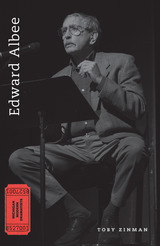 Edward Albee
Toby Zinman
University of Michigan Press, 2008 A theater lover’s guide to the dramatic works of one of America’s most important living playwrights Edward Albee was a giant in American theater, in the same pantheon with Arthur Miller, Eugene O’Neill, and Tennessee Williams. His prolific career included three Pulitzer Prizes and the 2005 Lifetime Achievement Tony Award. Albee continued producing major works for the theater into his eighties, including a prequel to The Zoo Story, which shocked the country when it first appeared in 1958—and his plays have seen major revivals on and off Broadway in recent years. Yet even with this resurgence of popularity, no up-to-date treatment of his plays is currently in print. With engaging discussions of his most famous plays, such as Who’s Afraid of Virginia Woolf and Three Tall Women, as well as his lesser known works, this essential guide reveals the heart of Albee’s drama, highlighting the themes of sex, death, loneliness, and time that have occupied the playwright during his more than fifty years in the theater. Toby Zinman is the theater critic for the Philadelphia Inquirer. She has written for numerous publications, including Variety,American Theater, and Theatre Journal. She is Professor of English at the University of the Arts, Philadelphia.
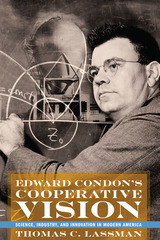 Edward Condon's Cooperative Vision: Science, Industry, and Innovation in Modern America
Thomas C. Lassman
University of Pittsburgh Press, 2018 As a professor of physics at Princeton University for nearly ten years, Edward Condon sealed his reputation as one of the sharpest minds in the field and a pioneer in quantum theoretical physics. Then, in 1937, he left it all behind to pursue an industrial career—first at the Westinghouse Electric and Manufacturing Company in Pittsburgh and then, by way of the federal government, at the National Bureau of Standards. In a radical departure from professional norms, Condon sought to redefine the relationship between academic science and technological innovation in industry. He envisioned intimate cooperation with the universities to serve the needs of his employers and also the broader business community.
Edward Condon’s Cooperative Vision explores the life cycle of that vision during the Great Depression, the Second World War, and the early Cold War. Condon’s cooperative model of research and development evolved over time and by consequence laid bare sharp disagreements among academic, corporate, and government stakeholders about the practical value of new knowledge, where and how it should be produced, and ultimately, on whose behalf it ought to be put to use.
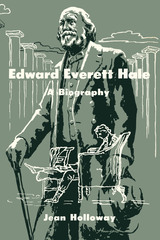 Edward Everett Hale
By Jean Holloway
University of Texas Press, 1956 Edward Everett Hale is remembered by millions as the author of The Man Without a Country. This popular and gifted nineteenth-century writer was an outstanding and prolific contributor to the fields of journalism, fiction, essay, and history. He wrote more than 150 books and pamphlets (one novel sold more than a million copies in his lifetime) and was intimately associated with the publication of many of the early American journals, among them the North American Review, Atlantic Monthly, and Christian Examiner. He served as editor of Old and New and was a frequent contributor to the foremost newspapers and periodicals of his time. Yet the writings of this “journalist with a touch of genius” were only incidental to Hale’s Christian ministry in New England and in Washington, D.C., where he was for five years Chaplain of the Senate. His literary creed reflected that of his ministry, for Hale’s interpretation of the social gospel comprised an active concern with all phases of human affairs. Confidant of poets and editors, friend to diplomats and statesmen, Hale helped mold public opinions in economics, sociology, history, and politics through three-quarters of what he called “a most extraordinary century in history.” In recounting Hale’s life and times, Holloway vividly portrays this fascinating and often turbulent era.
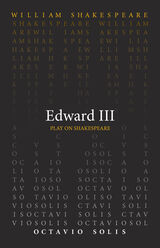 Edward III
William Shakespeare
Arizona Center for Medieval and Renaissance Studies, 2022 Edward III comes to life in a new version by playwright Octavio Solis.
Written after England’s victory over the Spanish Armada in 1588, Edward III follows the exploits of King Edward III and his son Edward, the Black Prince of Wales. England dominates on the battlefield as the play explores questions of kinghood and chivalry through the actions of King Edward and his son. Octavio Solis’s translation of the play provides all of the complexity and richness of the original while renewing the allusions and metaphors lost through time.
This translation of Edward III was written as part of the Oregon Shakespeare Festival’s Play On! project, which commissioned new translations of thirty-nine Shakespeare plays. These translations present work from “The Bard” in language accessible to modern audiences while never losing the beauty of Shakespeare’s verse. Enlisting the talents of a diverse group of contemporary playwrights, screenwriters, and dramaturges from diverse backgrounds, this project reenvisions Shakespeare for the twenty-first century. These volumes make these works available for the first time in print—a new First Folio for a new era.
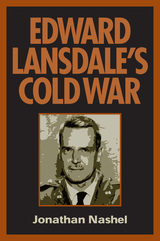 Edward Lansdale's Cold War
Jonathan Nashel
University of Massachusetts Press, 2005 The man widely believed to have been the model for Alden Pyle in Graham Greene's The Quiet American, Edward G. Lansdale (1908–1987) was a Cold War celebrity. A former advertising executive turned undercover CIA agent, he was credited during the 1950s with almost single-handedly preventing a communist takeover of the Philippines and with helping to install Ngo Dinh Diem as president of the American-backed government of South Vietnam. Adding to his notoriety, during the Kennedy administration Lansdale was put in charge of Operation Mongoose, the covert plot to overthrow the government of Cuba's Fidel Castro by assassination or other means.
In this book, Jonathan Nashel reexamines Lansdale's role as an agent of American Cold War foreign policy and takes into account both his actual activities and the myths that grew to surround him. In contrast to previous portraits, which tend to depict Lansdale either as the incarnation of U.S. imperialist ambitions or as a farsighted patriot dedicated to the spread of democracy abroad, Nashel offers a more complex and nuanced interpretation. At times we see Lansdale as the arrogant "ugly American," full of confidence that he has every right to make the world in his own image and utterly blind to his own cultural condescension. This is the Lansdale who would use any conceivable gimmick to serve U.S. aims, from rigging elections to sugaring communist gas tanks. Elsewhere, however, he seems genuinely respectful of the cultures he encounters, open to differences and new possibilities, and willing to tailor American interests to Third World needs.
Rather than attempting to reconcile these apparently contradictory images of Lansdale, Nashel explores the ways in which they reflected a broader tension within the culture of Cold War America. The result is less a conventional biography than an analysis of the world in which Lansdale operated and the particular historical forces that shaped him—from the imperatives of anticommunist ideology and the assumptions of modernization theory to the techniques of advertising and the insights of anthropology.
|
|
